Brian Meert's Blog, page 53
January 6, 2022
How to Deal with Amazon Hijackers: 4 Steps for Amazon Sellers

 Photo by John Schnobrich on Unsplash
Photo by John Schnobrich on UnsplashThere are many challenges that Amazon sellers face, but few are quite as frustrating and potentially damaging to sales as hijackers and counterfeits.
Scammers will copy your listing, start price wars, or even send threats – and Brand Registry doesn’t always prevent them from doing so, either. If you’re an Amazon seller losing sales from scammers and hijackers and are wondering what you can do about it, this article will provide you with all the information you need to save your store as quickly and efficiently as possible.
Why Amazon Hijackers Are a Common Problem Photo by Clint Patterson on Unsplash
Photo by Clint Patterson on UnsplashAmazon sellers are particularly vulnerable to hijackers for a few reasons. First of all, any seller can list their product on Amazon – which means that your listing could be hijacked by anyone.
Secondly, while Brand Registry does help when hijackers try to sell products with logos or other trademarked images in their listings, it doesn’t protect you from scammers who imitate your listings in other ways. All they need is some photoshop and switching up a letter or two, and they can fly under the radar for weeks or even months before you realize something is wrong.
This sneaky behavior makes it easy for scammers to hijack your listings and sell counterfeit products – which can result in lost sales, lower rankings on Amazon search results pages, and even legal threats from the original manufacturer of your product.
4 Common Tactics of Malicious Amazon Hijackers Photo by Towfiqu barbhuiya on Unsplash
Photo by Towfiqu barbhuiya on UnsplashThere are a few different tactics that scammers might use against Amazon sellers in order to hijack their listings:
1) Listing ImitationThey copy your listing, often with the only difference being a slightly different product name and/or altered photos in order to avoid getting caught.
These scammers are the ones you usually notice first because their listings are more or less identical to yours, but they can take away a lot of your traffic before they’re ever removed. Worse yet, it’s common for a new one to pop up almost immediately after you’ve managed to report the first one. If you’re doing retail arbitrage (e.g. building from Alibaba suppliers), there’s no discernable difference from the customer’s point of view between your Amazon business and the other seller because they’re likely selling the exact same product. They’re copying your Amazon listing to price gouge your product listings in the Buy Box, or just as a way to compete with your well-performing listing.
3) Counterfeit Product SalesSome Amazon hijackers will sell counterfeit products as they imitate your Amazon listings as well. Often, brand name and logo will be changed but not enough for many customers to notice. If you’re a brand owner with a good reputation, you’ll likely deal with multiple sellers attempting to hijack your product listings selling a counterfeit product.
The main difference between this and product or listing imitation is whether or not you have a trademarked product, private label product, and/or Amazon Brand Registry. Listing hijackers selling counterfeit products go beyond listing imitation to infringe on intellectual property. They can easily dupe customers into thinking that they’re buying from private label sellers and hurt your brand reputation in the process. They often show up in the Buy Box of your listings and the counterfeit or similar version of your product will attract customers with lower prices.
2) Account HijackingThey will hack your account, take your listing(s), and often change prices, descriptions, and more.
This is the most damaging type of Amazon hijacker because it can lead to your account being taken down. Oftentimes the hijacker has a competing listing or is a private label seller themselves, and has hijacked your account to make theirs look better and become the default seller. The changes they make can result in reports and policy violations that lead to your hijacked account being suspended and your listings removed at worst and unhappy customers or negative reviews at best.
4) Listing SabotageThey will intentionally damage your listing’s ranking using malicious tactics, but without imitating or directly hijacking.
The most common form of sabotage is price gouging. However, a more damaging form of listing sabotage is fake reviews. They will use fake buyer accounts and test buy your products in order to a negative review as a verified buyer or even report you. Some Amazon hijackers will threaten sellers with listing sabotage in addition to other forms of malicious selling to discourage the seller from taking action.
Though a counterfeit seller may use listing sabotage, some may have their own brand (and even Amazon Brand Registry). They target other sellers who are selling the same product even if the products prominently display differences and are clearly not from the same brand simply because they’re competitors.
How Do Scammers and Hijackers on Amazon Get Away With It? Photo by Elisa Ventur on Unsplash
Photo by Elisa Ventur on UnsplashAll of the above can be devastating to new sellers or even established brands, so why doesn’t Amazon do more about it?
Amazon support for sellers is notoriously lacking, but in this case, every day they’re unresponsive or unhelpful is costing you. This isn’t because Amazon isn’t concerned about hijacking or scammers on their platform, though – a lot of the changes they made to the a10 algorithm for ranking listings, for example, were to thwart malicious practices and boost the rankings of genuine Amazon sellers. Additionally, the company created the Amazon Transparency Program, the Amazon Project Zero Program, and Amazon Brand Registry to prevent hijackers from copying private label product listings and causing legitimate sellers to lose money.
Still, it’s hard to get Amazon support for fraudulent sellers because:
Amazon is too big for its own good.When you think about the hundreds of sellers in your category alone, it’s easy to see how your pleas for action can get drowned out in the chaos. The sheer amount of sellers and listings make it easier for non-legitimate ones to go unnoticed. Many products are produced in the same factory and aren’t brand registered, which can make it easy for an unsuspecting customer to fall for an Amazon hijacker thinking they’re buying the actual product from a default seller or registered brand.
Amazon’s values are exploitable.Amazon touts itself as a “customer-obsessed” company. Guess who isn’t a customer? You.
It’s hard to get Amazon’s support unless you’re a big brand or you can clearly outline that your problem impacts their bottom line – oftentimes, it doesn’t. Amazon’s Brand Registry and Amazon seller central help mitigate this to some extent, but if the hijacker’s product listing page has positive reviews and customers haven’t made complaints, it’s up to you to get the company’s attention or send a Cease and Desist letter (or both).
Trademark infringement and counterfeit laws get blurry overseas.It’s so difficult to take legal action against overseas entities that counterfeiting has become a legitimate, trillion-dollar industry.
Take Disney, for example. Disney is notoriously protective of its brand and anyone coming close to imitating it in the West will receive a cease and desist letter or trademark infringement claim very quickly. In China, on the other hand…
Anyone can make an Amazon account, and plenty of sellers and vendors are overseas. Sending a Cease and Desist letter to an overseas seller profile is a more complicated process than normal. Sometimes the trademark process can’t help either unless other countries were designated in trademark registration, giving Amazon hijackers a comfortable amount of space.
You’re dealing with professionals.If you’re lucky, you’re dealing with a single bad actor who will move on after you play whack-a-mole with the handful of accounts they have. But make no mistake – there are entire teams of scammers out there, some with employees on payroll and years of experience in exploiting sellers on Amazon. Some even hijack Amazon’s products on Amazon!
If you’re selling products from an overseas vendor and aren’t brand registered, you’re likely not the only seller. It’s not unheard of for vendors to do business with fraudsters. That’s not to say they’re in on it – many just can’t keep tabs on every single one of their sellers. But if the Amazon hijacker has language and locality on their side, it’s a lot easier for them to frame you as the counterfeit to the vendor, or at least plead their case enough to get away with what they’re doing.
How to Deal with Amazon Hijackers Photo by Nadine Shaabana on Unsplash1) Gather Evidence.
Photo by Nadine Shaabana on Unsplash1) Gather Evidence.In order to ensure your report is successful, be sure you have all the evidence you need to show exactly what you’re dealing with. Here’s what Amazon expects when you report a seller for policy violations:
The store or business name of the seller you are reportingThe ASIN or ISBN of the item’s detail page and the product titleThe marketplaces for which the violation has occurredA concise explanation of the violation based on the policySupporting documentation (for example, order IDs, related messaging, or receipts)Those last two are a bit vague despite being the most important. Save URLs of listings and screenshot what they look like. Feel free to highlight areas where fraud or imitation is apparent in photos or text. For example, if you have a private label product and the Amazon seller is claiming to sell the same product, save images detailing this (e.g. logos or anywhere in their Amazon listing that uses your own brand name).
Screenshot any messages or emails if the seller sent threatening messages.
Save comparable images of their Amazon listing and yours and note the dates when you collected this info – you can include the clock at the corner of your computer screen in your screenshots to be completely safe.
2) Reach out to the unauthorized seller.Once you’ve gathered everything you need, you can contact the seller without the risk of losing any evidence. Do not skip this before reporting to Amazon or reaching out to Amazon support, because they will ask you to do so if you haven’t. Additionally, record your communication with them as further evidence. Lastly, any communication you do without a lawyer or representative should be done with your buyer account instead of your Amazon seller account.
How you reach out to them depends on the nature of your case and your brand:
Sending a Cease and Desist letter to the seller is your best bet. You don’t have to anticipate going to court any time soon, it’s just a useful measure that makes your case go up in terms of urgency, or best case intimidates the hijacker enough to stop what they’re doing on their own. You also don’t have to hire a lawyer to send a Cease and Desist letter, but it’s recommended you do to ensure it’s legally valid and no mistakes are made.
If the former isn’t an option, message the seller directly. Do not send them all of your evidence. The goal here isn’t to tip your hand, it’s to let them know exactly what they’re doing and you gave them a warning before reporting. Also, be sure to keep a stern but non-emotional tone. It’s tempting to chew them out for the financial losses they’re causing, but you need to be sure you have no potential missteps or overreactions on your side.
Lastly, if the seller has more than one Amazon listing that hijacks yours, be sure to note the ASINs of all of them individually. This ensures each one is documented and there’s no grey area up for dispute.
Here’s an example message:
To whom it may concern at [Seller Account Name],
This is a formal warning to remove listing [ASIN Here] and cease [Violations Here] before your account is suspended. We have gotten [Exact Number Here] sellers permanently removed from Amazon in the past for doing exactly what you’re doing, and we do not take this behavior lightly.
You have [Exact Number Here] business days to remove [ASIN Here] before we take legal action and your entire seller account on Amazon is permanently removed.
This is your first and final warning.
Generally, 2-3 business days is a good timeframe to give, but it’s up to you. If you haven’t reported a seller in the past before, feel free to make that part up!
3) Report the Amazon HijackerIf you’re not a Registered Brand, you’ll need to fill out this form. You can also email seller-performance@amazon.com with a subject line like “Report a Violation: [Nature of your case]” e.g. “Report a Violation: Counterfeit Listing.” This may be less effective if you do so with an email not linked to your seller account.
If you are a Brand Owner, go to seller central dashboard and log in to your account. Once logged in, click on “Report A Trademark Violation” under the “Actions” tab. From there, you’ll require roughly the same information as above, but the process will be a lot more straightforward and likely faster. Once you have two successful violations against sellers, you’ll be given “project zero” protection, which will make it easier for you to protect your brand and report sellers in the future.
If your entire account was hacked, you have a few options. First, you can still email seller-performance@amazon.com and include any information you have to verify your identity and the fact that the account was originally yours.
You can also report your hacked account from a buyer account (make a new one if needed). There are two ways you can do this:
Through the customer service portal. You’ll be directed to a chatbot first, but once you’re connected with a customer service representative you can give them all of your evidence and explain your situation.By reporting them as a verified purchaser. To do this, you’ll have to test buy a product from the seller (their competing listing or your hijacked one should work). Report the product as a counterfeit and repeat the same steps mentioned from there.Leaving a bad review/answering questions noting they’re a fraud as a verified purchaser. After you test buy from them, go beyond reporting to leave a warning to other buyers and increase the chance of multiple reports being made.Some general advice no matter how you make a report to Amazon:
Though you want as much evidence as possible, keep your email/message short. You shouldn’t need more than 3-4 sentences to state your purpose of reporting.Focus on what’s important from Amazon’s perspective as a company – the policies being violated. As flustered as you may be, it’s important to stay on track to ensure your case gets dealt with in a timely manner.Here are the policies that Amazon looks out for in their words to include within your messaging:
Provide Accurate Information to Amazon and Amazon CustomersAct Fairly Without Misusing Amazon’s Features and ServicesNot Try to Damage Other Sellers, Listings, or RatingsNot Try to Influence Ratings, Feedback, and ReviewsNot Send Unsolicited or Inappropriate MessagesNot Attempt to Contact Customers Except Using the Buyer-Seller Messaging PlatformNot Try to Misuse the Amazon Sales ProcessNot Operate More Than One Sales Account on Amazon Fraudulently4) Monitor & WaitThough it can be stressful, keep in mind it takes time for Amazon to investigate your case. Having clear-cut evidence and all your information up front should prevent any unnecessary delays, but you’ll likely need to wait for 2 business days for any response. Additionally, Amazon does not disclose what action they decide to take after they’ve investigated.
In the meanwhile, check the hijacker’s page and listings to monitor the situation. You may see that their listings are taken down, were changed according to policies, and so on.
If the listing and/or seller account was not taken down within a week or two, continue documenting their policy violations with screenshots and dates. If the seller has stopped hijacking your brand image or listings but was not terminated, keep an eye on their account to ensure they don’t revert back to policy-violating behavior at any point in the future.
Conclusion Photo by Sharon McCutcheon on Unsplash
Photo by Sharon McCutcheon on UnsplashAmazon is a great resource as a side business or full-blown career, but it can be dangerous and complex as well. As an Amazon seller, you always want to make sure your account stays protected from hijackers and scammers who might try to imitate or copy listings. With this information, you will ensure that your evidence is valid and clear, you did everything Amazon wants you to do before reporting, and you’ll have the best chance at getting results.
If your brand is dealing with persistent and damaging counterfeits, hijacking, or other unauthorized selling on Amazon, it may be time to consult with a full-service Amazon ad agency. Our team of experts give Amazon sellers more direct representation and prevent hijacking from hurting your brand in addition to helping with other parts of your store like optimizing your listings, running ad campaigns, and more.
December 30, 2021
6 Hidden Ways to Optimize Amazon Listing & Rank Results


Photo by Austin Distel on Unsplash
Optimized listings on Amazon are easily discoverable in search results, have high click-through rates (CTR), have high conversion rates, and get more sales as a result. It sounds simple enough to start selling on Amazon, right?
Wrong.
95% of Amazon sellers fail within the first 12 months. Product listing optimization on Amazon in 2022 requires a whole new set of strategies and tips to rank in search results. These 6 steps for listing optimization will help you go beyond the basics to boost your rankings and ensure you stay in the top 5% this year.
Optimization =! Best Practices

Photo by NisonCo PR and SEO on Unsplash
You’ve likely heard the importance of things like relevant keywords and product images for your Amazon listing. Most how-to’s focus on keyword optimization, product title, and bullet points for Amazon listing optimization. These are good tips that result in good product listings, but good Amazon listings don’t sell.
The truth is, most advice out there is too vague to be helpful, and some tips (even from Amazon itself!) are plain wrong. They’re not telling you what makes a good listing great, they’re only telling you what the starting standard is. Not exactly the definition of “optimized,” is it?
If you haven’t gotten started with some search engine optimization basics like search terms and backend keywords for your Amazon listing, tackle those areas first before starting these 6 steps. If you’re already aware of common best practices, you can use these 6 hidden steps for Amazon listing optimization to make sure you’re in the 5% of successful professional sellers in 2022.
Step 1: Stand Out in Product Categories with External Traffic
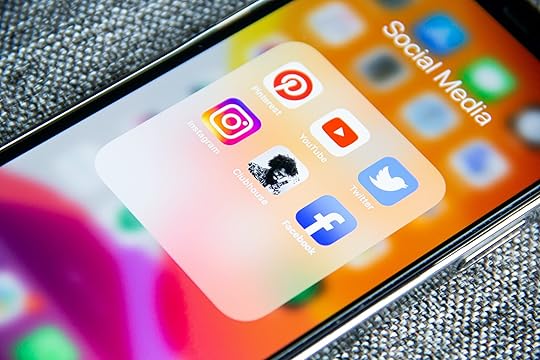
The external traffic you bring influences how optimized Amazon’s algorithm considers your listing and should play a key role in your Amazon SEO strategy.
Why is that? Firstly, impressions carry more weight in the a10 algorithm. A10 isn’t like other search engines. The current version of Amazon’s search engine algorithm is a10, and the biggest changes between the a9 and a10 algorithms all have to do with how much more a10 uses “credibility” to determine listing rankings. Impressions play a big role in how the algorithm determines your listing’s credibility.
Secondly, all of your competitors are optimizing their product listing for organic, on-site sales. They’re buying up Sponsored Product Ads, testing search terms, and doing practically anything else they can on Amazon to out-rank you in your product category. Taking your strategy offsite and on TikTok brings in more sales from areas with less competition, and the traffic makes you stand out as an Amazon seller. Many sellers have even used apps like TikTok to make their Amazon product Internet Famous.
You don’t necessarily have to start setting up a Google Ad to get it either: Amazon listings can get external traffic through social media, blog posts, influencer marketing, and more.
Even if you have your own website, you should consider directing customers to Amazon’s online marketplace. The boost in Amazon SEO isn’t enough for you to merge your Amazon marketing strategy with your other sales funnels, keep in mind that conveniences like Prime Shipping could increase customer satisfaction and provide the good customer service required for even more revenue long-term.
Step 2: Don’t Follow (Some) Amazon Listing Optimization Guidelines to Keep Relevant KeywordsTo be clear, you should follow all of Amazon’s policies. Don’t throw out the Amazon seller rulebook and expect to do well; this is only referring to best practices that have some wiggle room.
Which listing looks optimized to you?
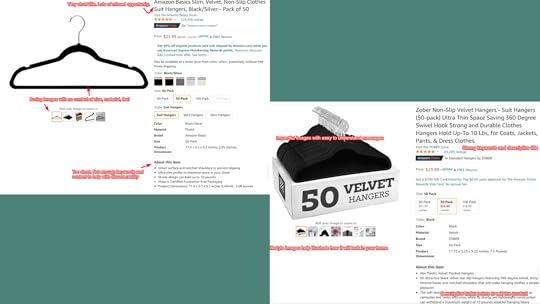
Source: Gorilla ROI
One breaks best practices to selectively add more than generic keywords in the title, bullet points, and product description, and add more descriptive terms in the title and bullet point section. The other followed guidelines.
These guidelines help make listings more uniform and basic so the site isn’t a mess and shoppers can make easy comparisons. They shouldn’t be ignored entirely but as Gorilla ROI points out, there comes a point where short and sweet won’t optimize your Amazon product listing or boost your click-through rate.
Don’t stuff all the keywords you can into your product title, product description, and bullet points but consider making thoughtful exceptions for important keywords and descriptive terms for key product features.
Step 3: Use Product Images, Video, and A+ Content for Emotional Appeal

Photo by Firmbee.com on Unsplash
A lot more goes into product image optimization and visual content than the right image frame and white background. Your Amazon listing should help your target audience visualize your product’s features. Product images, video, and A+ content optimize your Amazon product listing by helping potential buyers visualize:
Dimensions – how big/small is it? Even if you add this in descriptions, shoppers should be able to roughly estimate through your photos.Materials – especially important for products like clothing.Different Angles – what does the back of it look like? What about close up, or further away?Usage – what does the fit look like on a model? How would my child interact with the toy? How can this tool be used?Benefits – this is not the same as product features. Use simple text and/or imagery to convey the results your product achieves for the buyer.Whatever aspect(s) your main image can’t cover, your additional images and video should. Guidelines like “don’t include props” might prevent you from providing context in your main image. The rules for optimizing product images and video beyond main images are much more lenient and give you the freedom to add this context to your listings while still following site standards.
Use A+ content to visually summarize. A+ content (formerly Enhanced Brand Content) is not indexed so keyword rankings aren’t important. It’s especially useful for additional images and charts that help visually summarize your product description to the buyer. It’s a largely underutilized area of listings that isn’t as important as things like bullet points but can give your listing an advantage.
Step 4: Pay Attention to Your Q&A Section

Photo by Towfiqu barbhuiya on Unsplash
How embarrassing would it be to have high-quality images, good bullet points, and perfect promotional messages that catch a potential buyer’s eye, only for them to scroll down to the Q&A section and see this:
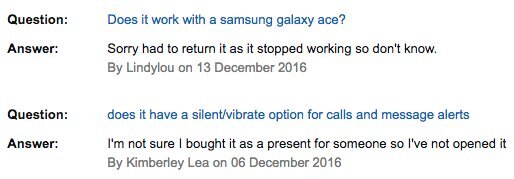
Source: Twitter.com
Unmanaged Q&A sections look unprofessional to potential customers searching through your product description. Nothing is stopping previous buyers from giving incomplete or inaccurate answers or negative feedback. Don’t underestimate what this can do to conversion rates or your likelihood of a bad product review because a buyer was misled by incorrect answers.
All of these scenarios affect your product detail page, which affects your product ranking. Keep an eye on the questions that pop up for your product so you can answer them properly before anyone else does.
Step 5: Base Your Prices on Your Listing’s StrengthTo optimize your product click-through rate, base your prices on how strong and optimized your listing is. A brand new listing without the credibility of good reviews and ratings won’t be able to increase rankings quickly if it’s priced just as high as established ones and won’t entice potential buyers as much if the product is not unique or is in a highly competitive category.
Many sellers start out at a net loss and slowly increase prices as the reviews, ratings, and traffic start coming in. This pricing strategy does help optimize your product listing, but it’s calculated risk sellers do with a firm understanding of their numbers. It’s also a sacrifice that not every seller can afford to make.
Regardless, if you’ve put in the effort towards listing optimization and it’s still not getting the traction it needs to rank well, consider whether your prices are a factor keeping people from clicking and how much room you have to change them. In many cases, a slight decrease in profit margins is all that’s needed to bring in sales and traffic to your product pages that pay off several times over in the long run.
Step 6: Use Ads Regularly for Amazon Listing Optimization (and Keyword Research)
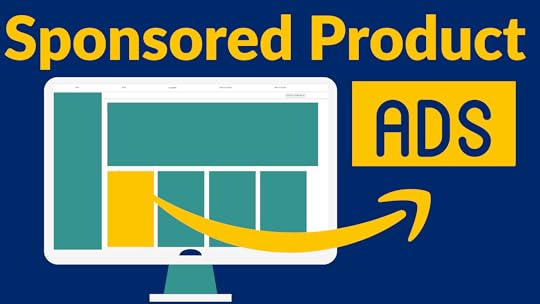
PPC ads are one of the first strategies mentioned for Amazon listing optimization. Sponsored Product Ads are a must for making strong Amazon product listings and should be seen as much more than a temporary boost in traffic and sales. With the right setup, they can be used to harvest keywords or even steal traffic directly from a competitor’s product pages.
The biggest mistake a seller can make is not considering ads as a continuous part of their overall selling strategy. There are a few reasons why this is true:
If you use Sponsored Product ads to find keywords, doing so only once or too rarely won’t provide optimal results. You won’t be able to keep up with changing trends in search terms and relevant keywords, and you won’t be able to refine your frontend and backend keywords enough.Ads can boost your ranking in search results even after the campaign ended, but this boost fades over time. Regular campaigns provide a consistent boost in search visibility in Amazon’s search results.Sponsored Ads are an affordable method to keep your product listings from falling behind in dynamic and competitive markets (and few sellers are not in a dynamic, competitive market). Even small campaigns can give important insight into what audiences to target and how to target them best or alert you to changing trends if you run them more regularly.The biggest reason why you should make ads a regular part of your Amazon product listings optimization strategy is in plain view on search results pages – just look at how many are Sponsored Ads.
Some see Amazon ads as a pay-to-win strategy because of this. They’re not entirely wrong, but it’s more accurate to see ads as a necessary part of selling on Amazon because your listing optimization will always be one step behind competitors who are using ads for maximum results – and most sellers are.
Strategic ad campaigns are important to enhance product discoverability, but the keyword here is “strategic.” To make sure your ads are set up in the best manner possible to help reach your goals, you need a lot of time to learn how Amazon ads work and how to optimize your ad spend. It’s possible to do it on your own if you’re starting out as a small Amazon Marketplace seller with only a couple of products, but most Registered Brands and dedicated entrepreneurs hire Amazon advertising agencies that have the time and experience to deliver make the best ads and optimization service for their Amazon product listings.
ConclusionIn conclusion, there’s a lot more to optimizing your product listings than typical SEO tasks like keyword research. The highest-ranking listings on Amazon incorporate these 6 steps into their optimization strategy, and if you’re not seeing the results you want, it’s time to revisit your listing and consider implementing them to optimize the lesser-known factors that influence your ranking in the algorithm.
There’s a lot more to Amazon listing optimization than we could fit into this article too – like optimizing Amazon keywords for mobile devices or brand registry – so check out our other articles about Amazon ads and tips for sellers for more helpful guides and inspiration.
December 24, 2021
The Best Time to Post on TikTok, According to Data
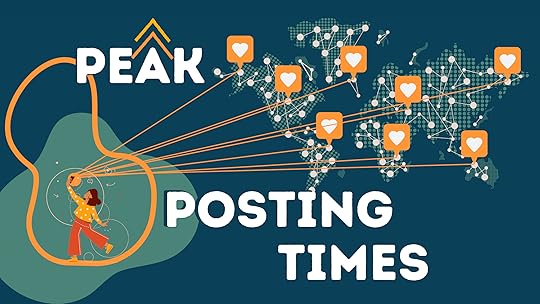

Does it matter what time you post on TikTok? The numbers show when you upload makes a difference. When you post on TikTok isn’t as important as when you post on Instagram or other social media platforms, but finding the best time to post on TikTok can still be an advantage that helps boost your engagement rates.
So what time should I post on TikTok, then?If we gave you a simple answer, we’d be giving you the wrong information. The right time to post depends on several different factors, and what day you post makes a difference too. When to post on TikTok for maximum views isn’t the same for everyone, but we made it as simple and easy as possible to figure out.
In this article, we compiled tons of information to help you determine what the best time to post on TikTok is on average, and how to figure out the best time to post for your account specifically. You’ll also learn three important tips about your posting schedule to ensure your content gets as much engagement as possible.
The Best Times to Post on TikTok According to Peak Posting Times

Not a lot of unique or fresh data exists on hours of peak engagement on TikTok compared to platforms like Instagram or Facebook, and the majority of sources trying to find the best time to post on TikTok cite the same study done in 2021. We compiled data from three separate sources and combined it with our own professional experience to get a better look at what the best time to post truly is.
There’s more than one best time to post on TikTok. In Pacific Standard Time (PST), the best times to post on TikTok are 4 am – 6 am and 9 am-2 pm on weekdays. On average, your TikToks are most likely to perform best when posted early in the morning (6 am – 9 am) or midday (11 am – 2 pm) of whichever timezone you’re in.
According to Later, 1 pm PST tends to be the best time to post during any weekday, but other sources found that TikTok videos posted early in the morning performed especially well, with some sweet time spots occurring midday or late at night.
After compiling all the data, we concluded that morning and midday are both peak times likely because people often log onto a social media platform when they wake up and at lunch.
Posting early morning or midday is a safe rule of thumb unless your audience lives in a completely different timezone than you or if they’re in a demographic with unique activity rates. Not sure if that’s you? No worries, we’ll get into that later on.
The Best Days to Post on TikTok, StatisticallyWhile the best times to post on TikTok globally are during the week, certain days result in better engagement than others. The latest data shows that Tuesdays, Thursdays, and Fridays are the best days to post for overall views and likes, while Mondays have the lowest viewership.
Here’s what all that information looks like put together in one posting schedule (for any time zone):
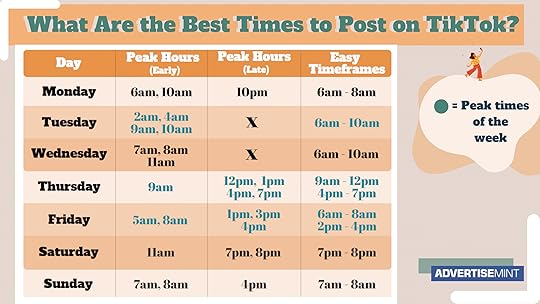
These averages make for a great starting point if you have a new account or less than 100 followers. Otherwise, it’s important to tailor your posting schedule to what best fits your target audience, especially if you’re using TikTok to make money or promote something.
Where your audience lives, their age and their interests can make your optimal posting times on TikTok completely different from the average. Once you have over 100 followers, TikTok gives you some helpful analytics data to make a posting schedule better suited to your account specifically.
When to Post on TikTok According to Your Target Audience

Mornings and middays are generally the best time to post, but what if you have a global audience? Sometimes, you can have several peak hours and days because your viewers are in different time zones. Once we factor these time zones in, making morning posts might not be a good rule of thumb for you like it is for others.
Your TikTok Videos May Have a Global AudienceNot targeting the right audiences is one of the biggest marketing mistakes you can make on TikTok, and this is true for regular users just as much as influencers or businesses. In other words, if you want to find the best time to post for your account, we need to find out more about your followers and make a content strategy unique to your account.
What is a Target Audience, and How Do I Know What My Target Audiences Are?A target audience is the group of people you are trying to reach with your account or content, and there may be more than one. For example, if your TikTok channel covers a variety of interests or genres, you probably have a few target audiences in multiple time zones. You can also organize target audiences by region, age, or gender, so if you have a large following in both the US and the UK, you can consider them two separate target groups.
You can figure out your target audiences by looking at who is already watching your videos and following you. TikTok has useful analytics tools to help you determine this information, so take a look at your account’s “Interactions” tab to see where your viewers are coming from.
If your audience is spread out, prioritize the 2-3 regions where you get the most engagement to find the best time to post.
Using TikTok Analytics to Find the Best Time to Post on TikTok

Where is your audience located? Depending on how many followers you have, the answer is in the analytics on your profile page. The data TikTok’s analytics section provides on your previous uploads and followers activity can help you determine TikTok posting times that get maximum engagement.
For regular accounts:Go to your Profile and tap the Settings menu on the upper right corner of your screenSelect “Creator Tools,” and in that menu, press the “Analytics” tabThe Analytics tab has a few key insights that are useful to determine when you should be posting videos. The two most important for figuring out the best time to post videos are “Content” and “Followers.”In the “Content” section, it will show your trending videos. Select a specific video and jot down the date and time you posted it along with its number of views, likes, comments, and shares.
Once you have this info for multiple videos, you’ll start to get a good idea of what times and days are working best for your account to determine the best time to post. You can also scroll down to “Video views by region” to understand what types of videos you upload are best for specific audiences.
In the “Followers” section, scroll down to “Top territories.” This section shows the top five regions where most of your audience resides.
Knowing your audience’s location can ensure you know the best time to post according to their time zones. Note: Access to this analytics information depends on how many followers you have (you need at least 100).
Take some time to record and organize this information in a table or spreadsheet. As you continue to post new videos, you’ll get a clearer and clearer idea of the best time to post to maximize your views.
For Business Accounts:TikTok Business Accounts or a Tiktok Pro Account can get more details on specific uploads and their follower demographics. For example, a Business Account or Pro Account can go to the “Content” section and get detailed information on all of their posts rather than just their trending posts.
Using a Business or Pro Account makes it easier to determine what the best time to post is (or more likely a few sweet time spots) and what days work best for your upload schedule.
Though having a Business or TikTok Pro Account makes this data analysis easier, it’s still a lot of information to process, especially if you’re a busy professional. Consulting a TikTok advertising agency can ensure you still get this valuable information and optimized results without putting in the time and energy. An agency also can help you improve even more aspects of your account besides finding the best time to post your TikTok videos like increasing your average watch time or video performance.
How Often You Post on TikTok Matters, Too

Just like most other social media platforms, how often you post on TikTok is also important if you want to boost engagement. For example, a person who makes TikTok posts consistently throughout the week might have their videos picked up by the TikTok algorithm into more ForYouPages than someone who posts less than once a week, even if the person posting once a week has more followers.
Frequency matters because of how TikTok’s algorithm distributes content, and it plays an even bigger role in content performance than finding the best time to post.
How Often Should You Post on TikTok?Posting a TikTok video every day is a good idea for brands and aspiring creators trying to become TikTok famous. If that’s too much for you, post on TikTok a minimum of three times per week to get the upload the consistency TikTok’s algorithm likes. Try to space out your posts evenly throughout the week to maximize this algorithm benefit.
Uploading videos throughout the week also ensures that you can target multiple time zones if you have more than one TikTok audience. For example, you can upload one of your videos at the best time for a specific region and target a different audience next time.
Can You Post Too Much on TikTok?Though multiple posts a week and consistently uploading is a good strategy to get more views on TikTok, there is such a thing as posting too much. If you’re uploading videos ten times per day nearly every day, you’re going to start overwhelming your followers, and they’ll be less likely to see everything you upload. The decrease in views per upload tells the algorithm to stop putting your videos in the ForYouPage as often and damages your ability to get more engagement and followers in the long run.
Tips for Posting ConsistentlyThe only people who get away with posting more than three times a day already have millions of followers on their TikTok account, so unless that’s you, keep these tips in mind:
Try to space out your posts evenly throughout the week and avoid bombarding people’s feeds with videos all at once.Keep it to 1-3 uploads a day and post them at least two hours apart from each other.If your content needs to be broken into more than one video, consider waiting a day or two until uploading the second part. You can always add the second video in a pinned comment on your first to make sure people see it, and the suspense you create can actually boost engagement and even get you more followers.Making an Upload Schedule for Your PostsFree Ways to Make a TikTok Post ScheduleNow that you know when to post on TikTok, it’s time to make a publishing schedule for your posts. Decide which days you want to post and what times you’ll be uploading each video to stay organized and ensure that all of your uploads are spaced out evenly.
You can schedule videos by drawing a table, making a spreadsheet, or using free scheduling tools like Later. Scheduling tools for social media can make the process faster and easier, especially if you post often.
Affordable Marketing Tools for Creators and BusinessesBesides the above example, there are also paid scheduling apps that include additional analytics information and tools to optimize when you post on Tiktok videos.
If you have a smaller account and audience, it might not be worth spending money on professional platforms and TikTok analytics from your profile will be enough. However, if you have over 100,000 followers, are an influencer, or use a TikTok Business Account, affordable marketing tools for small budgets like this can help you get even better results.
When to Post on TikTok in 2022: Important Tips

It’s important to keep in mind that when your followers are watching has likely changed and will continue to change throughout the year – especially once you start getting more followers. Knowing this, don’t research your target audiences once and call it a day. Check your TikTok analytics at least once a month (ideally once a week) to see what’s changed and adjust when you post accordingly to keep your TikTok engagement rates steady. Make sure to keep track of any changes so you can gather insights on your audiences over time.
2) Stay Ahead of Updates or Algorithm ChangesTikTok’s algorithm also changes any time the company decides to update it and understanding the platform’s algorithm is important when figuring out what and when to post. Though we can’t know all of the specifics, TikTok often gives insights into how the algorithm works or when it makes changes to the algorithm. Be sure to read up on these updates to check and see if your posting strategy or TikTok content needs to change.
3) High-Performing Content Will Always WinWhat you post on TikTok is more important than when you post, and that’s never going to change! Make sure your videos are creative and you’re making engaging content – something that your audiences will want to watch. If you’ve optimized your posting times and factored in time difference but still aren’t getting the results you want, dive deeper into your TikTok analytics. Fine-tune your content strategy with some inspiration from quality content made by other creators for ideas on high-performing content, and make sure you’re using relevant hashtags to increase discoverability.
ConclusionThe best times to post on TikTok depends largely on your target audiences and when they’re most likely to be using the app. Additionally, making sure you’re not posting too little or too much throughout the week will help give your videos a boost in the algorithm.
TikTok is best used as a tool to engage with your audience and share quality content that’s relevant, interesting, and engaging. Posting at the right time is one part of this, but making sure your videos delight your audience is essential to making your videos discoverable and getting more traction. Keep track of your TikTok analytics, posting time, and post performance to see what’s working best for you!
December 17, 2021
Notable Viral Marketing Examples to Inspire Your 2022 Strategy


Is there really such a thing as a strategy that can make campaigns go viral? Well, yes and no. The topic of viral marketing is not straightforward; that’s why we’ll uncover its colorful past, present, and uncertain future as we head into 2022.
What is Viral Marketing?The definition of viral marketing is a strategy in which a person, group, or company creates content designed to inspire a large number of people to share, engage with, and talk about it (a.k.a. go viral). The content can obtain a large audience rapidly and without paying in the same manner as traditional advertising because the audience increases its reach organically.
What is Viral Advertising?Like viral marketing, viral advertising aims to encourage large numbers of people to share content organically to promote a product or service, while viral marketing campaigns can encompass a wider variety of objectives.
Examples of viral marketing and advertisingWhat does good viral marketing look like?Do you remember the Fyre Festival? It might be a textbook example of how to not set up a large event, but before the Internet was making “fyre” memes about its failure, it had one of the best viral marketing campaigns of its time. In fact, the only reason why millions of people were tuned into its disastrous outcome was its social media campaigns were so successful, and they remain a brilliant example of viral marketing.
Fyre Festival’s viral marketing technique cleverly combined the power of influencers and human curiosity. Several noteworthy social media influencers – mostly Instagram models – gave the festival an initial audience to start with. They all posted a blank orange square with captions like “SO excited!!! #fyrefestival,” and the festival’s promotional video featured the orange square as a thumbnail.
This quickly got tons of people to pay attention simply because they wanted to know what the orange square on their feed was about and why Bella Hadid found it so exciting. The orange square became a meme of sorts as users reposted it to make their own followers perplexed and curious. Soon enough, entire feeds were covered in orange squares and the Fyre Festival was being talked about by millions around the world. Maybe if their marketing team was in charge of the festival, it wouldn’t have flopped so hard.
What does a good viral campaign look like?Old Spice created one of the most successful viral marketing campaigns to date. Their ad featuring actor Isaiah Mustafa was so well done that his character became the company’s mascot and a long-lasting theme for their advertisements. The original commercial “The Man Your Man Could Smell Like” aired in 2010, yet over a decade later, an astonishing amount of Americans still remember its iconic lines and cite it as one of the best commercials of all time.
Behind the scenes, Old Spice targeted “The Man Your Man Could Smell Like” very strategically on channels where couples were most likely to be watching TV together. Though the team probably didn’t anticipate just how successful the viral campaign would be, it was intentionally designed to be a cultural phenomenon. The content was memorable, funny, and compelling, but most importantly, its format and Mustafa’s lines were replicable. In other words, it was very meme-able. The ad reached far beyond its original viewer base wherever and whenever it was referenced.
YouTube gave the viral advertisement an additional 60 million views. Imagine making an ad so iconic, it starts generating its own income. Old Spice took advantage of the video-sharing platform even further in a lesser-known but equally-clever interactive campaign called “The Response,” in which Mustafa individually responded to comments from users on platforms like Twitter, Reddit, and Facebook in over 180 videos.
Sales of Old Spice body wash increased 60% that year.
Real-World Viral Marketing & Advertising StuntsOld Spice and Fyre Festival serve as straightforward examples of good viral marketing, but make no mistake: there’s a lot of different strategies within viral marketing that aren’t as direct. Guerilla marketing and viral marketing, for example, often go hand-in-hand.
Guerilla marketing is a promotional strategy in which companies use unconventional and/or unannounced stunts to reach and engage with their audiences.
Frozen Bananas for SaleTake this Reddit Post from 2013, for example:
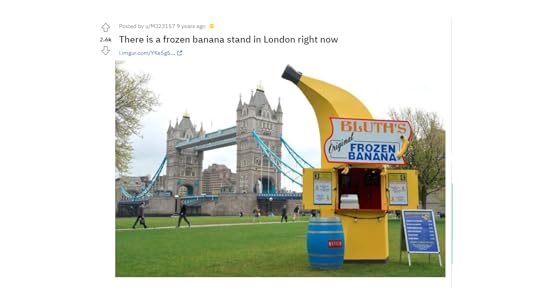
The Reddit user is not a marketer or influencer. They saw a frozen banana food stand while walking around London and found it so bizarre and funny that they figured it could earn some upvotes – which is exactly what Netflix was hoping for when they put it there.
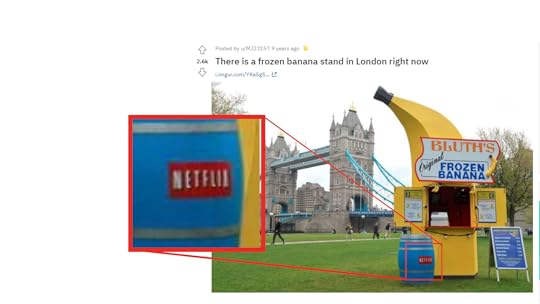
How does a random banana stand advertise Netflix in any way? It’s a reference to the show Arrested Development, and the Reddit user’s post proves how and why it works as a viral marketing strategy. Placing a show reference in a busy city seems subtle, but “sophisticated” is a more accurate description. Netflix’s stunt proves two concepts that are key to modern viral marketing strategies:
In the age of social media, your audience has an audienceLess obvious advertising =! less effective advertisingThink about it: do you think anyone would have found this as funny and awesome if Netlfix ran ads about it? How many people do you know that would walk past something like a frozen banana stand and not take a picture or tell any of their friends? It was only a matter of time before Burt’s Frozen Banana Stand appeared on every major platform. “There’s always money in a banana stand.”
IT’s (alleged) pre-movie marketingIt’s important to note that to this day, the producers of the 2017 horror film IT have consistently denied causing the Creepy Clown Craze of 2016. To be fair, it quickly became a problem – police were getting involved, embassies were warning citizens of potential clown dangers, and Mcdonald’s had to stop using its mascot for a while. Plus, even if New Line Cinema had (allegedly) sent out a few rogue clowns at any point, they certainly weren’t the core of the craze. It went viral in the first place because putting on a clown costume is a very easy way to scare approximately 12% of the human population.
The timing is conspicuously in-line with the buildup to IT’s release. Also, viral marketing stunts were a verified component of the film’s promotion. In Melbourne, thousands of Australians were treated to red balloons on multiple street drains. They were accompanied by “IT IS CLOSER THAN YOU THINK” neatly spray-painted onto the pavement.
It was clever and achieved its goal of creeping people out while creating interest in the film. And even if IT had nothing to do with the clown craze, both stunts combined helped IT earn over $317 million – hundreds of millions more than any other scary movie that year.
Viral Marketing Before the InternetIf history can borrow the term “viral marketing,” The Sun may have had one of the best campaigns of all time. The Sun was an emerging New York newspaper and the workplace of reporter John Locke in 1835. Locke had a bone to pick with companies like The Atlantic for publishing absurd articles, like Thomas Dick’s “celestial science” publishings. They were about the 21 trillion biblical creatures he calculated were on the moon (based on the population of England – very scientific), so it’s not hard to understand why Locke called it an “outrage upon science.”
Locke decided to mock the media status quo by writing a fake story in The Sun, using its sensationalism to provide the paper with more readers in the process. He pretended to be famous astronomer John Herschel, proclaiming that a new telescope had allowed him to see unicorns, beavers, and “Vespertilio-homo” (Latin for bat-men, literally) on the moon.
Locke’s stunt worked. The Sun rapidly obtained a massive audience for its time as people scrambled to get their hands on each new editorial for the latest details on the moon batmen – Locke somehow made The Sun go viral with nothing more than a printing press. After six editorials, The Sun admitted it was all fake and the Great Moon Hoax was officially over. The story became a cult phenomenon, arguably one of the first examples of viral marketing, and possibly the first meme; it was common to see The Sun’s depictions of moon people framed in people’s houses. Even the astronomer Locke impersonated thought it was funny until he realized how annoying it is to be a living meme.
The Sun maintained much of its audience from Locke’s hoax and continued on as a popular non-satirical newspaper until 1950.
Not all marketing that goes viral is viral marketing.Not all viral campaigns come from viral marketing. In fact, it’s more common for ads and marketing stunts to go viral unintentionally and for the wrong reasons, usually due to one or more of three things:
ControversyCountercultureCringe-worthy ContentControversyBrands trying to advertise aren’t the right messenger for social issues, so one misstep can lead to a controversy that goes viral. Viral infamy from this strategy is so common it’s become documented research with quantifiably poor results, but for some reason that hasn’t stopped big brands from creating their own controversy for the world to see.
A recent example is Tesco’s 2021 UK ad for the holidays. It was intended to be a “lighthearted take” on the pandemic-related struggles we’ve experienced this year. Santa has his vaccine passport, allowing him to avoid quarantine and make it in time for Christmas. Queen played in the background. Everyone clapped.
The ad received over 5,000 complaints from the public to the Advertising Standards Authority, the second-highest record in its history.
Starbucks managed to gain an even larger amount of online hate when it made the #RaceTogether campaign to fight racial intolerance and “start a conversation” about ethnicity in America. They did indeed start a conversation – multiple, all over the Internet, about their corporate urge to cash in on a delicate topic.
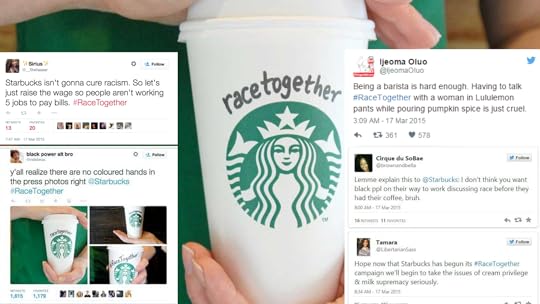
The wild west days of the Internet left behind a counterculture that remains strong within many online communities. A long list of companies accidentally come across Internet counterculture when their ad campaigns catch the attention of Reddit, Encyclopedia Dramatica, 4chan, and 8chan. In most cases, it’s because the campaign had a weakness that large numbers of people could collectively exploit for fun. Though it’s nowhere near as damaging as controversy, the wrong kind of attention from the Internet can completely ruin a campaign.
Brands are becoming more aware of how organized these communities can be if they feel like it, but it was a tough learning curve throughout the past two decades. It took nearly a decade for businesses to learn to avoid polls in their marketing campaigns:
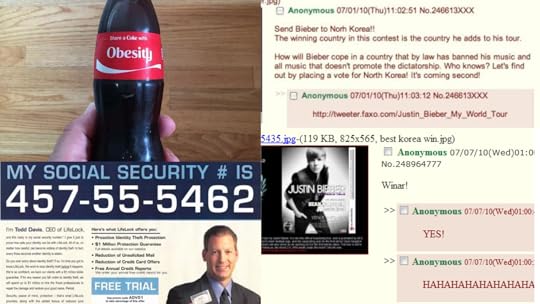
Any time viral messages call for interaction, there’s a chance this part of the Internet will remind them to be careful what they wish for. For example, SeaWorld probably should have thought harder about how polite the discussion was going to be in their #AskSeaWorld campaign on Twitter. LifeLock’s CEO should have considered that several people absolutely would try to steal his identity for years when he dared them to in his 2007 commercials. And how did a company like Coca-Cola not consider the possibilities when allowing people to custom-fill bottle labels?
Cringe-Worthy ContentSometimes all it takes is an awkward delivery for a brand to be lambasted by the Internet. There’s nothing social media loves more than gathering around in the millions and collectively saying “Wow, that’s cringe.”

On the surface, it sounds like the most harmless form of negative viral attention. Professionals stuck in traditional marketing mindsets often make this mistake, and it costs them their brand reputation in the long run. On the Internet, being out of touch is a much bigger crime than being controversial or crude. You’d be hard-pressed to find anyone who remembers the Starbucks #RaceTogether campaign despite its heavy subject matter; the same cannot be said about Wendy’s 2018 “Like a Boss” commercial.
The reason why these campaigns are cringe-worthy isn’t just because a joke didn’t land or the message wasn’t conveyed well. It’s also the fact that the try-hard and/or outdated messaging proves to an ad-conscious demographic that these companies are trying to sell products to customers they don’t understand.
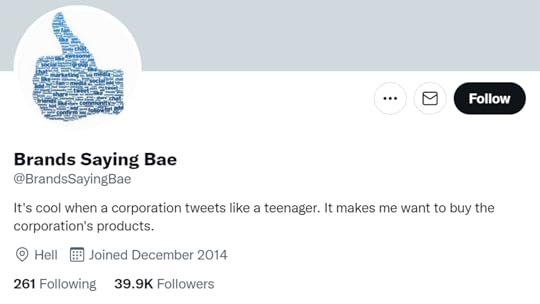
All of the noteworthy successful viral ad campaigns mentioned were launched several years ago. Of course, it would be helpful to get some more recent examples. The problem is, if you look up the top results for “viral marketing campaigns” or “viral ads” in 2021, you’ll get results like Coke’s “Real Magic” campaign holiday ad, or Fisher-Price’s “See toys everywhere” campaign. Does anyone remember these? The bar for “viral” seems to be getting lower.
What qualifies as going viral?Some try to slap quantifiable views like “5 million” onto the definition of viral, but in truth, viral content isn’t quantifiable – the manner in which it becomes a cultural phenomenon makes it near-impossible and also pointless to count views. When something goes viral, you know because everyone knows.
Content with that kind of virality doesn’t seem to come from strategies like it did a few years ago. Why is that?
Digital Marketing Killed Viral Marketing TechniquesThe landscape in which viral marketing found its sweet spot in social media marketing no longer exists.
The number of social media platforms we use has increased.The content we consume on them is personalized more than it is popular.Our online communities have gotten less communal.Our perspective on brands and advertising has soured.Businesses overstayed their welcome online both on social media and in digital ads. They desensitized people by advertising too much, they used authenticity as a marketing message instead of a value, and they made “relatability” untrustworthy over time. When paired with the natural evolution of social media, it was a death blow to strategies that worked well just a few years ago.
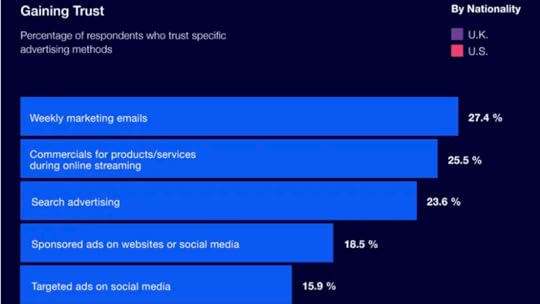
If people don’t like brands enough to give them word-of-mouth advertising, forget going viral.
Viral Marketing Campaign Strategy in 2022It wasn’t entirely honest to say no ads went viral in 2021, but the only true candidate has a complicated backstory. According to TikTok, was an error, not an ad – allegedly.
The “error” was an accidental mix-up of the creatives for an Amazon ad and a random video. This resulted in random, slightly horrific yet slightly funny audio with games like Roblox being played on screen, ending with a link to Amazon for perplexed viewers to click. It got millions of views on TikTok and within days, everyone online was wondering what on Earth this ad was, who made it, and why.

The problem is, this explanation doesn’t make any sense. The link in the ad was to the search term “revealhome1,” not a product or store, meaning no specific thing or seller on Amazon was being promoted. Plus, no one ever came forward as the original owner of the “random video.” You’d think the creator would want to take credit for it after it accidentally managed to outperform professional ads with a fraction of the budget despite having no product, right?
Here’s a conspiracy theory: The link is a search term on Amazon because the advertiser was a rouge seller using search arbitrage to cheat their way up in search results (or maybe on the Amazon Internet Famous Page). And of course, TikTok wouldn’t like to admit that a fraudulent advertiser had not only snuck onto the platform, but his unconventional tactics and chaotic editing also made one of the best viral campaigns in 2021.
New -Age “Cool” is ChaosChaotic editing is a method of creating content that invokes frantic, unsettling, but also humorous feelings. The videos or pictures use strange audio clips, and low-quality visuals as well as editing characterized by sudden, fast, and/or drastic changes that complete its “chaotic” feel. It’s not a new content style and lighter forms of it are all over the Internet – deep fried memes, for example – but gen z and TikTok have made chaotic editing more mainstream.

Take a look at the full video yourself to get an idea of what that looks and sounds like: it’s strange, but still somehow structured and purposeful. It’s exactly what makes a TikTok user curious enough to click a link, just like blank orange squares did on Instagram for Fyre Festival.
Perhaps it is really just a random glitch, but it deciphered the code to virality we seem to have been missing regardless:
In the age of social media, your audience has an audience.Less obvious advertising = more effective advertising.In an endless sea of information and ads, meaninglessness and chaos “gets it.”December 3, 2021
How to Use Customer Match for Google Ads with Zapier


Zapier announced its Customer Match feature is now more widely available for Google Ads to all eligible users. As an expert Google Ads agency that uses Zapier’s automation features in our own campaigns, our team knows how useful Customer Match is to reach advertising goals and increase return on investment (ROI), making its expanded capabilities for Google Ads big news.
This article will introduce the Zapier and its Customer Match tool, tell you how to get started using Customer Match for Google Ads with Zapier, and outline its benefits for first-party audience data in ad campaigns.
Introduction to Zapier and Customer Match What is Zapier?Zapier is a web-based automation tool that allows users to connect different applications together. The company calls these connections “Zaps” and they make automation more widely available without large teams or coding knowledge required. This allows for streamlined workflows between various programs, saving time and improving productivity.
What is Customer Match and what does it do?Zapier’s Customer Match feature allows users to automatically import and update customer information from a business’ CRM system, website, or marketing tools for advertising purposes. This means you can find and target your Google Ads campaigns to specific customer email addresses, phone numbers, names, and location information like zip codes and countries without having to manually add the data yourself. Most importantly, if the information from your sources changes, Zapier will automatically update this within your custom audience list for your Google Ads.
Customer Match has four main settings: Targeting, Observation, Similar Audiences, Manual Bid Adjustments, and Exclusions. Both online and offline data can be used to make custom lists for Display, Search, Shopping, YouTube, Discovery, or Gmail Google Ads campaigns.
Who Can Use Customer Match?Previously, using Customer Match features for Google Ads customer lists was only available to Google Ads users that had account managers and a lifetime ad spend of $50,000 or more. This is no longer the case, but certain features of Customer Match are still limited based on these requirements.
Essentially, to use the main features of Customer Match with Zapier for Google Ads, your account only needs to have a history of following Google’s policies and paying on time in previous ad campaigns. If you want to use some of the more advanced features, you can check out the qualification details on Google’s Support Page.
How to use Customer Match for Google AdsNow that you know what Customer Match is and what Zapier can do with it, let’s walk through a quick example of how to set up your custom audience list.
Preparing your DataBefore you begin, you should take the time to make sure the data you want to use is applicable. Custom lists for Google Ads can only use first-party data from your direct sources, like mailing lists, loyalty programs, and so on. You also need to make sure your data is compliant with Google Ad’s policies for ad campaigns. For example, ensure your ad does not target any customers under 13 years old or involve sensitive targeting categories.
Double-check to make sure your data is formatted correctly. It needs to be in a .csv file and have properly labeled headers: “Email” “First Name” “Last Name” “Country” “Zip.” Make sure you remove unnecessary spaces, add country codes to phone numbers if they aren’t already included, and that all names are lowercase, e.g. john instead of John. To make this process easier, consider starting with lists using only one type of customer information before using combination lists.
How to Add Contacts and Make Customer Lists for Google AdsFirst, make sure you have a Zapier account and that you’re logged in. Then, go to the “Create New Zap” page on Zapier and select “Google Ads” as your trigger app. You’ll be asked to connect your Google Ads account.
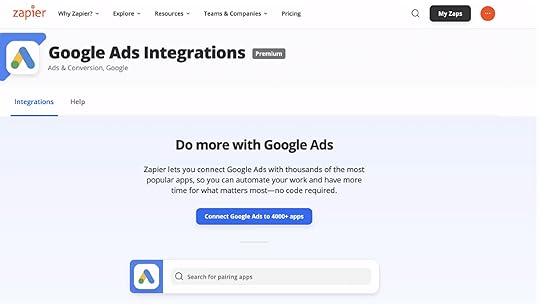
After that’s set up, you’ll be asked to choose the action app. Select “Customer Match” and then “Add/Update Customer.” Zapier will ask you to connect your customer data source.
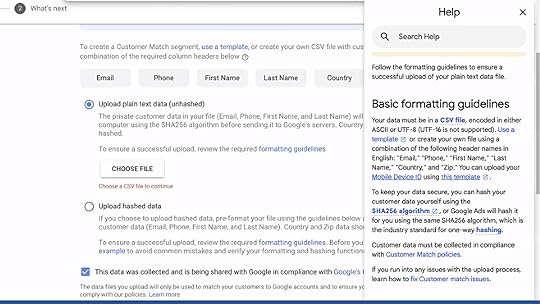
Next, Zapier will ask you to match the required fields between your Google Ads account and your customer data source. This is where you’ll select the email address, name, phone number, and other customer information that you want Zapier to import into your Google Ads account.
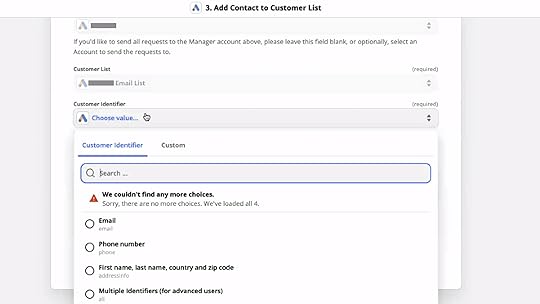
Zapier will ask you to select an Action event. Each action like removing or adding contacts needs to be its own Zap, so you have to create them one at a time if you’re setting up multiple. Here we’re choosing to add customers automatically to our Google Ads customer list.
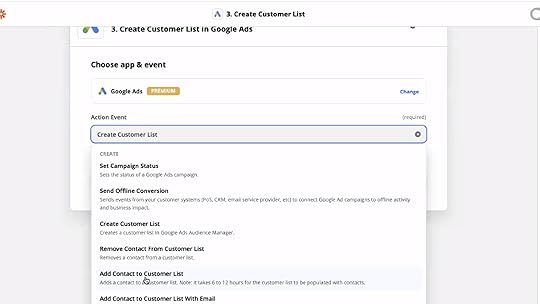
Finally, Zapier will ask you to test your Zap. Once you’ve verified that everything is working correctly, or chosen to skip the test, turn on your Zap!
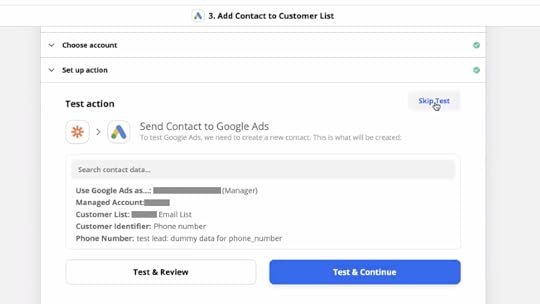
Now that you know how to use Zapier with Customer Match for Google Ads, here are a few things to keep in mind:
Know that not all of your data will be successfully matched. Customer Match can only work if the customer data you have can be matched to a Google Account, so not all of your data can successfully be used.You should aim for a minimum of 1,000 contacts when uploading for optimal results.Segment your data to create more specific customer lists. If you want to target a very specific subset of your audience, use Zapier’s “Combine Data” feature to group customers by interests, demographics, and other factors. This is especially important when using the “Similar Audiences” setting so your lookalikes are more accurate.The benefits of using Customer Match for Google AdsNow that you know how to use Zapier with Customer Match for Google Ads, you can get more out of your ad campaigns in several ways:
Better upselling and cross-selling. Customer Match can help you target customers who have already shown an interest in your products or services on other channels, resulting in quality cross-platform marketing and for brick-and-mortar companies, omnichannel advertising.Reduce costs by using automated list management. Zapier’s features can remove duplicates, add and remove contacts, and keep your customer data clean and up to date, so you don’t waste money on ads targeting invalid email addresses or people who have unsubscribed from your list.Create lookalike audiences that are even more relevant to your target market. Customer Match can help you find potential customers who are similar to your existing customer base, so the audience will likely be those that have a high likelihood of being interested in what you’re selling.Wrapping UpCustomer Matching is a powerful way to target customers using first-party data for Google Ads, and Zapier’s new integration makes it easier than ever to use that data for your ad campaigns. By following these simple steps, you can create custom audiences lists that are relevant to your business and help you reach more potential customers.
If you’re not using Zapier with Customer Match for Google Ads yet, now is the time to start! With this powerful combination, you can get more out of your ad campaigns and improve your chances of reaching potential customers. And if you find Zapier’s Customer Match tool useful for your Google Ads, consider checking out the other platforms that Zapier can also be integrated with to benefit even more from automation.
November 24, 2021
How to Advertise Your Etsy Shop: Free & Low-Cost Methods


Just like with any small business, advertising an Etsy shop can seem like an overwhelming task. There are so many options, learning marketing strategies on your own is time-consuming, and many advertising methods can get expensive fast. But don’t worry! This article is a complete guide that will break down all of the different ways you can start advertising or promoting your Etsy Shop cheaply or for free.
How Does Etsy Marketing Work?Advertising an Etsy shop can be very different from advertising other online businesses. For example, you don’t need to have your own website to run an Etsy shop. This is convenient in many ways, but it also limits your ability to use traditional advertising methods. Ad platforms like Facebook Ads Manager are a great way to get exposure, but without a custom domain, you’re advertising Etsy instead of your shop.
To complicate matters further, your winning marketing strategy for your Etsy store depends on several factors unique to you and your business: product categories, marketing goals, your audience of potential customers, and more. If you’re not at a stage where hiring an advertising agency is possible, figuring this out on your own can be complicated.
That being said, there are still many ways that you can advertise your Etsy shop effectively (and yes, even for free). Once you have a clear idea of your different options and in what situations they work best, creating a strategy to generate more sales on Etsy is surprisingly easy!
How to Promote Your Shop On Etsy

Let’s start with a marketing method every Etsy seller has: Etsy’s advertising platform. Etsy offers easy-to-make ads to your target demographic at a very affordable price. Here are the benefits:
Etsy can place your ads in search results (which means they show up higher in searches), Category Pages, and Market Pages both on desktop and in the mobile app.You don’t need to have a website or blog.You don’t have to spend any time or money-making ad creatives (photos, text, etc.). The platform uses your product listings photos and information to make your ads instead.You can make ad campaigns that are flexible for any budget – the minimum ad spend per day for an Etsy ad campaign is $1. Etsy will target your ads according to the settings you use for your shop and product listings, such as keywords and countries you can ship to.There are a few downsides as well:
Your ads are limited to the Etsy marketplace, so you can’t reach outside of it. You have little control over where your ad will show up on the site – for example, if an item isn’t selling well in searches or category listings but is popular with shoppers after they’ve visited a product page, there’s not much you can do to change this. The only way you can change your ad targeting is by changing your entire shop’s settings and keywords.For most Etsy shops, running ads on Etsy will be enough exposure to bring noticeable results. It’s a great place to start if you’re new to eCommerce, so don’t feel like you have to go beyond this step if you’re working with limited time and resources. The option to create an Etsy ad campaign is in the Marketing section of the Shops Manager.
Other Marketing Methods on EtsyThere are other ways you can drive more traffic to your products without leaving Etsy. Etsy offers tons of informative material for sellers to interpret their analytics information and optimize their shops to bring in more sales. You can use keyword finders like Keyword Tool Dominator or find affordable product photographers on Fiverr to optimize your Etsy shop and attract more customers from searches.
Using Social Media to Attract Customers to Your Etsy Shop for Free

Do you want to know how to advertise your Etsy shop for free? The answer is social media! In this case, we’re not talking about paid advertisements — just regular business accounts and smart social media marketing. Business accounts don’t cost money to operate on most platforms as long as you don’t create ad campaigns, so they’re a risk-free advertising method to start experimenting with. They offer detailed analytics information that will be very useful for your Etsy marketing strategy and give key insights into how to attract more quality traffic to your Etsy shop, not just passerby’s.
We’ll break down some basic methods to use for the platforms most suitable for promoting Etsy stores with a limited budget or no budget at all: Pinterest, Facebook, Instagram, and TikTok. But before we do, let’s go over some common mistakes that sellers make when marketing on social media that could hurt your potential for sales:
Don’t Make These Social Media Marketing MistakesPromoting on your personal accounts. Use a separate (preferably business) account dedicated to increasing sales and traffic to your Esty shop and finding a wider audience. A different account will help provide more accurate audience analytics and keep your account looking professional. Treating posts like ads. You won’t reach new customers with blatant non-stop promotion. Instead, reach out to your audience with relevant and beneficial content for them so you can build up a rapport. Find ways to engage in conversations with other sellers on social media platforms, too. Connecting with other Etsy sellers on social media is a great way to reach new potential customers who have already shown interest in similar businesses. Promoting on the wrong platforms. Make sure to research where most of your viewers and potential customers are so you know which social media platform(s) they’re using. We’re listing four different social media sites in this guide, but most likely, only 1-3 are the best fit for your audience demographics. Other platforms like DeviantArt might be worth looking into depending on your products as well.Not posting consistently. Whether big or small, all businesses need to keep their social media accounts alive with content at least 2-3 times a week. Posting consistently throughout the week gives your content a boost in algorithms like Instagram and TikTok and allows you to connect with more people via different content styles.How to Promote Your Etsy Shop on PinterestPinterest is the go-to platform for most people promoting an Etsy shop. It’s a great way to reach new customers, its user base is similar to Esty, and it’s easy to get started. You can even integrate your Pinterest account into your Etsy account using the Shop Manager Social Media Tool.
If you’ve never used it, Pinterest is like a visual search engine – search results pop up with images, which contain links to products, blogs, videos, and more. People search for terms related to what they’re interested in or products they’d like to buy and pin their favorites to create boards.
To promote your Etsy products on Pinterest, create a few boards where you can pin your product listings in addition to re-pinning others to make your boards visually appealing and interesting. The more people like your board and re-pin your products, the more attention you get!
How to Promote Your Etsy Shop on FacebookFacebook is one of the most popular social media platforms out there, and that means it has a huge user base. It’s also free to use for business accounts, which you can create through your personal account for easy login access.
Facebook maintains a nice balance between social media and shopping. It is perfect for small businesses like Etsy sellers because showcasing yourself as an individual can enhance your marketing on Facebook and help you connect better with your audience. For example, you can post your latest customized creation for a happy customer (and tag them if they follow you) and post a cute picture of your cat the next day. These little snippets of your character give your business an identity, which results in better connections with your audience.
How to Promote Your Etsy Shop on InstagramInstagram is Facebook’s younger sister, and Meta (formerly Facebook) owns both. The same methods generally apply on Instagram and Facebook to promote your Etsy store. There are only two main differences you need to know about: audience and hashtags.
Firstly, Instagram’s audience is younger, so keep that in mind regarding your content and how you brand yourself on Instagram. Secondly, hashtags are more important on Instagram to help your posts find more people. You can also use hashtags on Facebook, but for Instagram, it’s a must. You can get inspiration for what hashtags to use by lurking around other Etsy seller Instagram accounts or brainstorming what search terms might be related to your post.
How to Promote Your Etsy Shop on TikTokTikTok is like the new kid on the block, but it’s “the” platform for gen z and millennials. It hosts all types of content – artistic videos, memes, tutorials…the list goes on. TikTok has dedicated niche communities like #CleaningTok — yes, all stuff about cleaning — and the users have created jokes and content unique to the platform. If your customers are generally 25 years old or under, TikTok might be the best fit for your business.
If you want to promote your Etsy shop through TikTok but haven’t used it before, you should take some time to lurk around. Search and browse through different hashtags you think could be related to your audience. For example, if you sell handmade skirts, check out #sewing, #sewingtiktok, and #sewingtok. Look through the content and check out the other hashtags people are using and the content they make. Be sure to get inspiration from business accounts on TikTok too; you’ll need to consider both personal and business content to attract customers as an individual seller.
To make your Etsy products popular on TikTok, create content that showcases your talent and personality without directly promoting, and leave your shop links in pinned comments and your bio. Think about both the people who like your products and the people who have the same skillset – give tutorials and tips, or make a timelapse of you creating a product with a fun voiceover. People love authentic community content like this from small businesses and will share it far and wide!
Promoting an Etsy Shop for Free on Social Media: Key Takeaways
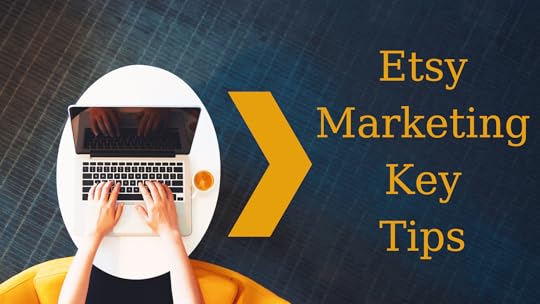
To sum up all those points in a shortlist, keep this in mind when you set out to start marketing your Etsy shop on social media:
The platform you use matters. Try and think of your customers and what they’re like — their average age, interests, etc. — and focus on platforms they’re most likely to use. Stick to 1-3 at most so your marketing efforts aren’t spread out too thin.Promote yourself, not your products. Though it’s not like a personal social media account, your Etsy account on social media should be showcasing interesting things about yourself and what you do. Leave your links and business info in your bio or comments for the most part. Sneak peeks of new products or product announcements like sales are great sometimes, too! Just be sure there’s a healthy mix of other content like how-to videos, behind-the-scenes photos, etc.It’s all about the content. Each platform has a different vibe, so don’t go in blind. Familiarize yourself with your audience and take some time to brainstorm what they might find funny, cute, or interesting. You want to be sure that your content doesn’t feel out of place in potential customers’ social media feeds, so keep up-to-date with relevant and related content to your Etsy shop and customers.Engage with your audience. Don’t be a ghost that only makes posts and nothing else. Interact with your audience through comments, tag other Etsy professionals in a similar field, compliment posts you like, and make genuine business connections to maximize your reach and turn fans into customers.Growing Beyond Social Media MarketingIf your Etsy business is starting to generate serious sales, it might be time to invest in a website and paid advertising. Luckily, that doesn’t have to be a hassle! An Etsy Plus subscription gives you a unique domain while allowing you to stick with the platform you’re familiar with, or you can use services like Squarespace to make a website without any coding or advanced computer skills.
However, if you’re just starting or are running a small Etsy shop, paid advertising might be a bit too much to bite off right away. It’s important to get the hang of social media marketing before you start investing in other ways of expanding your business.

As you can see, there are plenty of ways to market your Etsy shop cheaply or completely free. With the right social media marketing tactics, you can get the word out about your Etsy business without breaking the bank. It’s important to understand your audience and each platform’s characteristics to craft a strategy for your Etsy content so you don’t come across as blatantly promotional and can connect with your potential customers on a more personal level. With all this in mind and your newfound Etsy marketing strategy, you’re well on your way to growing your business and keeping customers coming back for more!
November 16, 2021
3 Foolproof Ways to Promote Your Music on TikTok
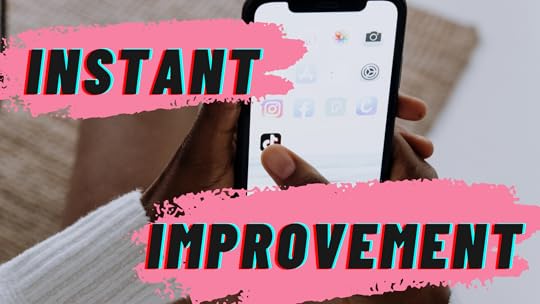

TikTok is the perfect platform to make musicians and their songs famous overnight. There’s tons of potential to showcase your talent, gain a following, and make money just by making some TikTok videos. But it’s not always easy to promote your music on TikTok. Just take a look at Lil Nas X, who has used TikTok as a part of his music marketing strategy; it’s clear he puts a lot of thought into his uploads to get the attention he does! A lot goes into making good content, there’s a lot of competition, and it can feel defeating to put in the work only to get no results.
Whether you’re hoping to get noticed and gain a following, have one of the hottest TikTok songs, or you’re hoping to make money with your music on TikTok, this article is for you. We’ll go over some of the common mistakes musicians make when promoting their music on TikTok and give some helpful tips we use as a TikTok Advertising Agency to help our clients promote their music the right way.
Understanding TikTok’s AudiencesTo promote your music on TikTok effectively, you need a decent understanding of the differences between content on TikTok versus other platforms like YouTube or Instagram. If you don’t already use the app yourself, start lurking around as a user to get a feel of what content people like. Start by looking at artists on TikTok in your genre. Take note of what their audience is like, the hashtags they use, and their content style. Look through other non-music communities on TikTok that are related to your audience based on their age and interests. The more you familiarize yourself with the app and the communities you think would make for a good audience. The more you’ll know how to join in to promote your songs on TikTok.
Basic Do’s & Don’ts of TikTok for Beginners
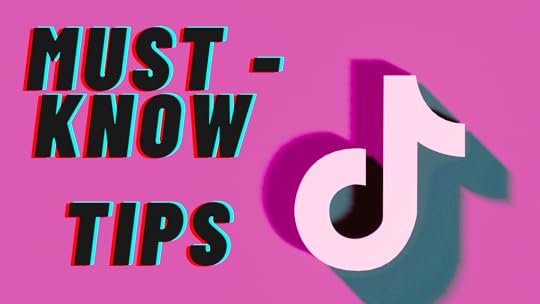
Audience research is unique to you and your music. However, there are some basic things to know about TikTok that apply to everyone:
TikTok is not meant for long content. Even though technically you can make 3 minute-long videos, TikTok is not the place to be posting entire songs. Your content will always do better if it’s around 30 seconds long.Captions should be 9 words or less. People go on TikTok to listen and watch, not to read. Captions that are too long will disengage people from your content and, in many cases, can make it hard to view your video. Don’t recycle content from other platforms. Though TikToks do surprisingly well when reposted on different platforms (except IG Reels), the reverse is seldom successful. To help promote your music on TikTok more effectively, save your videos for fresh content that is made specifically for the platform and your unique TikTok audience.If the hottest hashtags on TikTok aren’t relevant to your video, don’t use them. Be mindful about what hashtags to use to promote your songs on TikTok, or else you’ll just end up on the wrong side of the algorithm. This will do nothing for your video if you aren’t able to get people watching it, liking it, and engaging with it.3 Foolproof Methods to Promote Your Music on TikTok the RIGHT Way1. Show, Don’t Tell: Promote Yourself, Not Your SongsAvoiding direct promotion can be difficult for musicians because in many cases, it’s your livelihood, and your goal is to get more people to listen to your music. Simply put, making broad or vague appeals for new fans on TikTok won’t get you very far – people use TikTok for entertainment, not suggestions about what kinds of things they should be interested in.
That being said, there are tons of great ways to showcase your talent that will directly lead to revenue. Take a look at Jordy (@iamjordy), who went from a tiny following to becoming TikTok famous practically overnight. At first, Jordy made TikTok’s using clips of his songs, with text on screen telling people where they can purchase his music and how much it would mean to him if they did so:
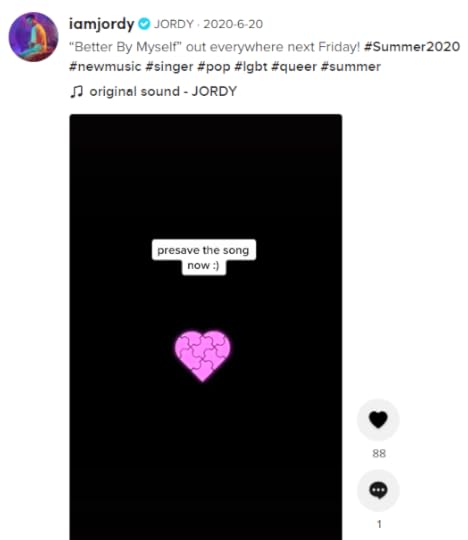 Source: TikTok.com
Source: TikTok.com
Even though he was very genuine and his music had appeal, this wasn’t getting the results he needed. One day he uploaded a clip of him at his piano candidly practicing a song idea that he had, but had not completed. Within just a few days, he had thousands of new fans who couldn’t wait for this song to be released so they could stream it! His off-the-cuff video idea made him go viral on TikTok.

Source: TikTok.com
What Jordy accidentally discovered is something that applies to every musician. No matter how great your song, album or concert is, creating content using your talent instead of about your talent will always perform better. It’s the classic rule of “show, don’t tell”. Leave all links and purchase information in your bio or in a pinned comment so interested viewers can find it easily, but keep your video itself focused on content people will find interesting.
2. Encourage Engagement & Make Connections to Gain More Fans
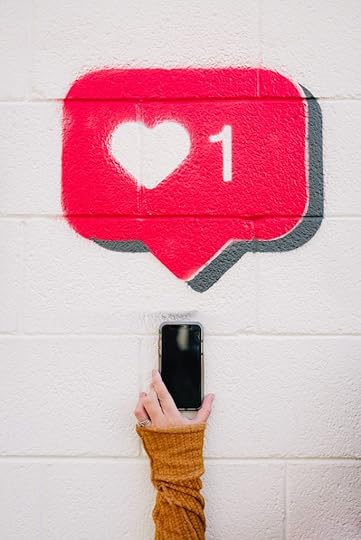
Photo by Karsten Winegeart on Unsplash
Getting people to engage is one of the best ways you can grow your audience, and TikTok makes this super easy! TikTok is all about community engagement – this is especially true for the musical side of TikTok, where plenty of passionate musicians create fun challenges, do fan requests, and more. Promoting engagement can be as simple as asking viewers a question in your caption to encourage their comments or literally dueting with another musician by Dueting their TikTok (and tagging them).
The key to thriving on TikTok as a musician is turning casual viewers into fans who love your content so much they want to interact with it and share it with others. Find fun ways to make your musical talent relevant to different audiences, relatable to people’s emotions or experiences, or worthy of Stichting/Dueting a response to.
Get clever about relating to your audiences. TikTok has an incredibly diverse range of audiences and it’s important to keep this in mind when creating your content. It’s best to post at least 2-3 times per week to get the best results, so use this opportunity to create a variety of different types of content to suit multiple audiences and interests. Your creativity can make your options endless, but a good start is looking at trending hashtag challenges; they have active audiences and can be a great way to show off your talent in a different way.
3. Tap Into Niche Audiences to Promote Your Music on TikTok

Photo by Shingi Rice on Unsplash
In addition to catering your content towards a wider audience, it’s also important that you create content that serves niche audiences actively looking for music. Finding ways to connect with people enjoying content about other topics is another way to promote your music on TikTok.
For example, Eurovision is a popular annual contest featuring amazing singers from all over Europe, and they have a huge following of dedicated fans on TikTok who appreciate the incredible talent and catchy songs they feature. Pick a song and do a cover in your style, use hashtags related to the song and contest, tag the artist and Eurovision’s accounts, and you now have made your music relevant to a whole new audience of potential fans.
ConclusionTikTok gives passionate musicians and artists a platform to showcase their amazing talent and find millions of future fans, and the app is changing the music industry as we know it. However, tapping into this audience is only the first step to notoriety. If you want to promote your music on TikTok the right way, you need a foolproof strategy.
Using the “Show, don’t tell” rule for your TikTok content, encouraging reaction and response within your videos, connecting with niche audiences, and being clever with how you relate to different audiences are all key components of getting the most out of TikTok as a musician. With all this in mind, becoming famous by promoting your music on TikTok is within your reach!
November 3, 2021
Amazon Interactive Audio Ads Turn Commands into Conversions


During its Unboxed 2021 event, Amazon announced that interactive audio ads are now available on Amazon Music’s ad-supported tier. The 10 to 30 second long ads are a beta feature currently only available in the US. The unveiling of Amazon interactive audio ads follows a similar announcement of interactive video ads for Fire TV earlier in the year.
It’s clear that Amazon is making interactive marketing a priority for its platforms and sees huge potential in it. But what can interactive audio advertising do to change the audio marketing game, and what potential does it have for businesses and Amazon advertisers? This article will explain how interactive audio ads work, the pros and cons, and why Amazon’s interactive audio ads may have an advantage over others.
Introduction to Interactive Audio AdsWhat is interactive advertising?Interactive advertising is a marketing technique that encourages consumer participation to promote engagement. With the rise of digital advertising and social media, interactive ads have become an increasingly popular way to provide a personalized experience. A common example of interactive advertising you’ve likely seen is a playable ad promoting a game or app.
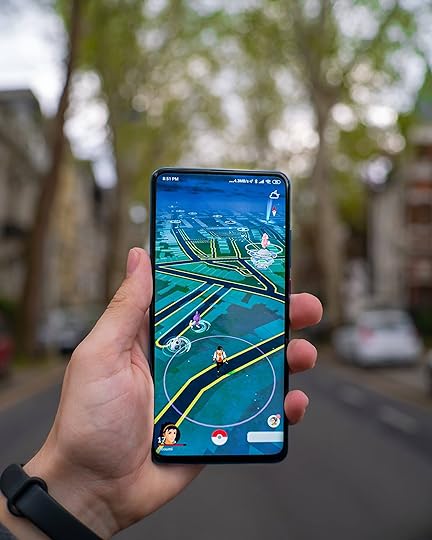
Source / Mika Baumeister on Unsplash
Why make audio marketing interactive?Audio consumption via digital streaming services and apps is flourishing, and only 32% of the population pays for ad-free music. Despite this, the market for audio advertising is very small in comparison because the format limits the options brands have to advertise effectively. Taking the visual component out of digital ads removes the ways brands usually engage with potential customers, collect information on interested audiences, and measure ad performance.
Interactive Advertising for Music StreamingInteractive audio ads are fairly new to the scene in comparison; it wasn’t a feasible method until AI voice assistants became commonplace. Pandora was one of the first major music streaming platforms to invest heavily in interactive advertising in 2019. They did so with the help of Instreamatic, which specializes in AI-driven dialogue advertising. The company started running voice-enabled interactive ads for large brands the following year.
One brand that used Pandora’s interactive ads successfully was DiGiorno. After the listener was told they were listening to a voice-enabled ad and they could respond with “yes” or “no,” the DiGiorno ad started with a joke: “What did the Digiorno rising-crust pizza say to the oven when things started getting heated?” Users who gave a “yes” would hear the punchline, while a “no” would end the ad.
Beyond Listening: Learning to Answer Audio Ads

Instreamatic’s AI was very similar to Alexa and was capable of complex conversation. So why did Pandora opt for a simple yes/no format for its interactive ads? It turns out that it wasn’t the AI that needed to learn to adapt to them – the audience did. Pandora realized during testing that before each ad played, they required a voice actor to inform the listener that they could respond to the ad. Options beyond “yes” or “no” were too confusing to introduce the concept of interactive ads to listeners. Users are generally engaging with music apps passively, so teaching them to talk back to ads requires a bit of time and instruction.
How Alexa gives Amazon’s interactive audio ads an advantageAmazon’s interactive audio ads won’t have this major drawback. The audiences of these ads have Alexa, meaning they’re already familiar with Alexa’s capabilities and regularly give her complex commands. Like Pandora, Amazon is starting with relatively simple response options and will include a brief introduction to the concept of voice-enabled ads before they run. Still, they’re already leaps and bounds beyond a “yes” or “no.” Listeners can tell Alexa to “Remind me,” “Send me more information,” or “Add to cart,” and Alexa will either set a reminder, send an email containing the advertised product’s landing page, or add the product to the listener’s purchase list.
Understanding Audiences with Interactive Audio MarketingThe “yes” or “no” options for Pandora’s ads were also used to collect audience targeting information, and it is still some of the best performance measurement data available for audio marketing today. Amazon Music interactive ads will provide even more audience information, as its response options categorize interested audiences into three defined groups versus one.
Turning ad copy into conversationInstreamatic’s CEO is confident that interactive ads for music streaming will have far greater ad targeting potential once audiences and brands grow accustomed to the format. The AI capabilities of smart assistants like Alexa could take unique responses and create hyper-detailed listener profiles for advertisers to use. For example, instead of saying “yes” or “no,” a listener could tell the DiGiorno pizza ad “No thanks, I’m lactose intolerant,” and both Amazon and the advertiser would now know to present them with dairy-free options in the future.
Brands also have to grow accustomed to interactive audio marketing features for them to reach their full potential. The more complex responses people can give to interactive ads, the more intricate the ads need to maximize engagement and avoid being repetitive. The engagement factor of AI-driven dialogue applies to advertisers as well as audiences. Brands need to learn to create genuine conversations with listeners that sell rather than simple marketing messages.
Giving Audio Ads Frictionless EngagementAmazon describes its new interactive audio advertising feature as a “frictionless” and more natural way for listeners to engage with ads on its platform. It’s an accurate description — the native feel of interactive audio ads on music streaming apps is a huge advantage compared to traditional ads. The lack of effort required from the listener to respond to the call-to-action is revolutionary, which is why Pandora and other companies also see so much potential in interactive advertising for music platforms.
 Source / Photo by Fausto García-Menéndez on Unsplash
Source / Photo by Fausto García-Menéndez on Unsplash
39% of Alexa users said they’d respond to an interactive voice ad on Amazon Music, and 29% of them make a purchase every day. These findings from Amazon point to very favorable odds for advertisers, especially when considering CPA rates. In comparison, most audio ads on music streaming platforms see conversion rates of 0.25%-0.73%, with display and banner ads on music apps averaging a CTR below 0.20%.
Ordinary audio ads force brands to decide whether they want their ads to be engaging or pleasant, but they can’t have both. Display and banner ads can be used to prompt engagement, but most music listeners aren’t engaging with the visual component of the app in the first place. In the rare case that they are, clicking on these displays becomes an annoying disruption to their music. The only other option is creating passive audio ads that have high CPM rates despite having barely any direct impact on conversions. With these crippling limitations and high costs, it’s no wonder why most businesses don’t see audio advertising as a profitable option.
SummaryAmazon’s beta interactive abilities for audio ads will be available for Amazon Music’s ad-supported tier and is currently only available for US advertisers using Amazon audio ads. Though it is not the first music streaming service to implement interactive audio capabilities for advertisements, Amazon has distinct advantages compared to Pandora or Spotify that brands should consider when investing:
Listeners have Alexa and will not need as much time and instruction to start responding to adsAmazon’s “Add to cart” allows advertisers to use audio advertising for objectives beyond brand awareness and cover the entire sales funnelThe three responses: “Remind me,” “Send me more information,” and “Add to Cart” allow for more detailed audience targeting and performance measurement dataThat being said, interactive audio advertising in general still has some hurdles that Amazon will need to overcome for them to reach their full potential for advertisers:
Listeners need to learn to engage actively with audio ads versus passively listening to themBrands and marketers need to adjust their strategy for interactive audio advertisements to ensure they are as personalized as possible and not repetitive.ConclusionThe future for interactive audio marketing on music apps and streaming platforms is bright and full of opportunities. Audiences can engage with the brands they love in a way that doesn’t interfere with their listening experience, and advertisers are restrained from the limitations traditional audio ads have on conversion rates, targeting, and performance measurement. Now that Amazon has entered the world of interactive marketing for its music streaming service, the company can help bolster the innovation and normalization of interactive audio advertising along with startups like Instreamatic. The progression of interactive audio ad capabilities from Pandora’s testing in 2019 until now is impressive; it will be interesting to see how much the technology and strategy will evolve in the coming years with Amazon now onboard.
October 28, 2021
Is Walmart Connect the Next Big Thing in Digital Advertising?


Walmart Connect is a media entity you should be paying attention to. It’s well known that Walmart fiercely competes with Amazon for the title of America’s largest retailer, but few know about its media company Walmart Connect, and its determination to become a key player in digital advertising. The retailer announced the launch of the Walmart Connect DSP in 2021, which has been one of their biggest moves as a media company yet.
After months of waiting, Walmart Connect is finally here, and the platform’s unique attributes look promising. If you’re not sure how it works or why Walmart Connect might be advantageous for your business, read on!
What is Walmart Connect?Walmart Connect is the retail company’s advertising business. Previously called Walmart Media Corp., the company changed its name in 2021 after Walmart started investing heavily into its ad platform, rapidly creating new features and capabilities for advertisers.
Previously, the subject of Walmart advertising was largely reserved for large corporate brands or Walmart Marketplace sellers. Walmart was never considered a major digital advertising opportunity like Facebook or Amazon, but the company is on a mission to change that. From hiring former Amazon ad executives to launching a DSP, the retailer is clearly determined to make Walmart Connect a big deal in digital advertising.
Walmart’s underestimated advertising potentialWalmart has good reason to start taking its advertising capabilities seriously. Just like Amazon advertising, Walmart gives businesses the opportunity to zero in on potential customers and capture their attention when they’re most willing to buy products. The ability to advertise while audiences are shopping has major competitive advantages compared to platforms like Facebook or Google, which struggle to cover the entire sales funnel with its ad platforms.
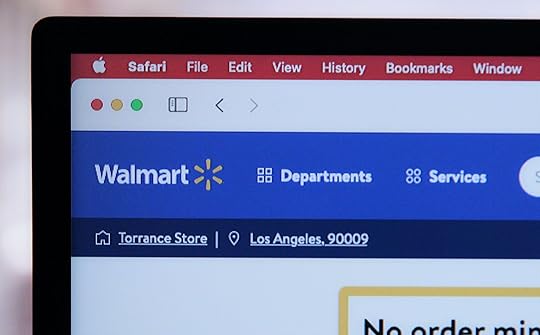
Source / Marques Thomas at Unsplash
Investing in and growing its advertising potential also benefits Walmart immensely. The company has plenty of space to turn into profitable ad placements both online and within its thousands of brick-and-mortar locations. Many of its advertisers are also sellers, so their ads direct audiences back to Walmart to make purchases. In fact, Walmart nearly doubled its sales this year thanks to its digital advertising initiatives before the Walmart Connect DSP even launched.
Lastly, Walmart Connect’s digital ad platform has some distinct advantages for advertisers compared to other leading platforms, which we’ll get into later. Needless to say, Walmart’s advertising potential and its fast-paced progression should be on every marketer’s radar.
How Does Walmart Connect Work?Though Walmart Connect refers to the retailer’s entire advertising business, its latest endeavors focus on two platforms: Walmart’s DSP and DMP.
The Walmart Connect DSP (demand-side platform) was announced back in August 2021 and just officially launched this October. DSPs are a type of digital ad platform that manages ad bids and placements automatically, making it easier for advertisers to buy them – Facebook Ad Manager and Amazon DSP are two other notable examples of DSPs.
The Walmart DMP (data management platform) is where advertising businesses can collect information from Walmart’s database to create customer profiles and segment audiences. This is then used to improve ad targeting and personalization.
What types of ads can you run with Walmart Connect?The platform categorizes its advertisement solutions into 4 ad types:
Search ads – keyword-based advertisements that appear when customers are searching for relevant products.Display – ad placements that can appear throughout the internet on non-affiliated sites and Walmart.com. Walmart Connect display ads are targeted based on customers’ shopping history.In-store – Ads displayed on self-checkout screens and digital media screens throughout Walmart’s brick-and-mortar stores. The company estimates they currently have over 170,000 in-store digital displays across its 4,700 stores. Brand Interactions – interactive content to engage with customers and increase brand loyalty.Who can advertise on Walmart’s ad platform?Because it is a growing platform, Walmart Connect aims to attract as many advertisers as possible with its DSP. Luckily, this means that it can be leveraged by brands that may not have benefited from Walmart advertising in the past: The platform allows for both national campaigns as well as smaller, local targeting options.
You can fill out this form to see if you’re eligible to advertise on Walmart Connect. Alternatively, if you have questions about your eligibility, or about creating a Walmart Connect advertising strategy, you can contact us and our ad experts will reach out to you.
4 Key Benefits of Advertising with Walmart ConnectWalmart Connect advertising has numerous specific advantages over other leading digital ad platforms because, in reality, it’s not limited to digital – Walmart Connect ads are just as omnichannel as the retail company is. It’s important to note that Walmart Connect doesn’t work with a first or last-click attribution model, as it focuses more on the overall consumer journey instead of just online interactions. Now that Walmart’s advertising business has a DSP and extensive digital advertising capabilities, this enables Walmart to provide brands the specific benefits listed below:
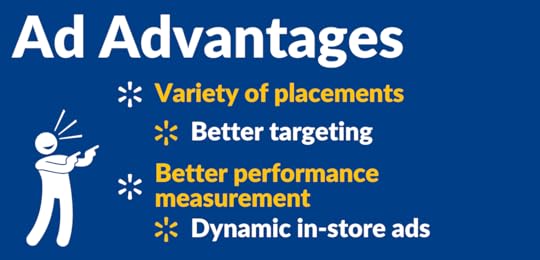
All of these benefits can be summed up to outline Walmart Connect’s most powerful advantage to advertisers: Its omnichannel data and omnipresent ad placements give brands omnipotence. All other leading ad platforms are owned by Internet mega entities limiting you to their spheres of digital influence. Not only does Walmart’s partnership give Connect advertisers ubiquity online, but its stores also bring dynamic digital ads to life.
ConclusionWalmart Connect is set to become a major player in digital advertising. With dynamic ad targeting capabilities, incredible online and offline reach, and access to omnichannel data, advertising with Walmart has a lot of lucrative potential for advertisers. Thanks to its latest launch of the DSP, all of these benefits are more accessible than ever. Considering its potential as-is and the company’s fast-paced innovation, it’s safe to say that the future of Walmart Connect will be interesting to stay tuned for.
October 21, 2021
The 3 Types of Sponsored Ads: Easy Seller’s Guide to Advertise on Amazon


If you’re hoping for an easy way to market your store and increase product sales, Amazon ads are one of your best bets. But who can make ads on Amazon, what are the different types, and which type of Amazon ad is best for you?
This guide will answer all of these questions and more so you can start advertising on Amazon and get more customers clicking ‘Add to Cart’.
Why should I advertise on Amazon?
The benefits of advertising on Amazon are threefold:
It’s easy. Unlike Facebook or Google, making an effective Amazon ad is straightforward. For example, a lot of attention to detail on ad copy and images is needed to make a Facebook campaign successful. In comparison, Amazon sellers have found that they can create ads with their existing product photos and listings content and still see a great ROI.It’s direct. Facebook and Google ad targeting options, though precise, are educated guesses based on peoples’ interests. Amazon’s audiences have their credit cards ready to go, and Amazon knows exactly what they like to buy. Don’t underestimate the power of the consumer data Amazon can provide advertisers: You can even add the ASINs of your competitors as a targeting option, allowing you to broadcast your better deal to shoppers who bought or showed interest in their product. Your ad can even be displayed as they’re about to buy the competitor’s product – that’s some direct advertising!It’s profitable. A lot of factors go into the outcome of an ad campaign, but Amazon on average delivers the most bang for your buck. The cost-per-click (CPC) of Amazon ads are usually lower, they require less time to set up, and they have higher conversion rates. All of this results in more sales, revenue, and a better ROI compared to advertising on other platforms. Who can advertise on Amazon?
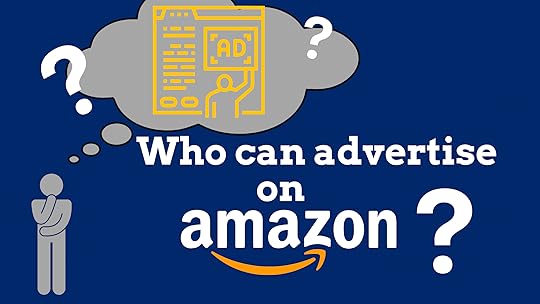
For Sponsored Product, Sponsored Brand, and Display advertisements:
Those who have a seller accountThose who have a vendor accountNote: You may have read of a loophole for stores off Amazon called Vendor Express. This is no longer true because the Vendor Express Program shut down in May of 2018.Unfortunately, this means businesses with no presence on Amazon cannot utilize its ad services. However, many that have their own website or primarily sell off Amazon still find having a seller account beneficial for business, so becoming a seller on Amazon is worth considering.
There is also the Amazon DSP (Demand-Side Platform), which is accessible to companies both on and off Amazon. These are video, audio, and display ads that can either be placed on Amazon or on affiliate platforms like Kindle or Twitch.
Setting up DSP ad campaigns requires programmatic advertising experience or an Amazon advertising agency, as they are more technical and complicated (take a look at all of the Amazon DSP ad targeting options, for example) and typically require 5-digit ad budgets.
In this article, we are focusing on the 3 main ad formats for Amazon:
Sponsored Product AdsSponsored Brands Ads (previously called Headline Search Ads)Sponsored Display Ads (previously called Product Display Ads)There’s far more to know about these Amazon ad types besides the simple definitions above, though — each has different purposes, placements, costs, pros and cons, and so on. We’ll go through everything to know about each ad format, and use this information to discover which ad type is best for your next campaign.
Sponsored Products Ads

Sponsored Products Ads feature a single product from your Amazon store. Once a user clicks on your ad, they will be directed to your featured product’s details page. They are PPC (price per click) ads, meaning you are charged only when someone clicks on your ad. Targeting options are based on keywords and ASINs, which you can enter manually or have the platform’s advanced algorithms determine automatically.
Sponsored Products Ads lets your product get ahead of the competition and receive more exposure from shoppers, especially if your product is new, lacks reviews, or is in a saturated category. Strategically, they’re also a great method of gathering data if you don’t have much to start with.
For example, if you need to do some keyword harvesting, you can create a Sponsored Products Ad campaign and select the automatic targeting option. Amazon’s algorithms will outline the keywords it determined as most relevant for your product, which you can then use for your product listing and for future ad campaigns.
Where are Sponsored Products Ads placed?Your ad can appear above or below search results pages or on product detail pages of competitors according to the keywords you use for the campaign.
How much do they cost?Technically, your ad spend can be just $1 per day. The “ideal” budget depends on your category, product, keywords, and your advertising goals. Your bidding price determines how quickly your budget is spent and the likelihood you’ll outbid competitors for ad placements, so your budget should consider your bid costs and how long you want the campaign to run.
When Should You Use Sponsored Products Ads on Amazon?If your product needs more exposure. Maybe your product listing on Amazon is new, is in a competitive category, or it’s ranking low on search results and you don’t know why. Not only will a Sponsored Products Ad boost your listing ahead of the competition while it’s running, but you can use the data reports Amazon provides to improve your listing’s organic search rankings as well.
If you’ve never made an Amazon ad before. A Sponsored Products Ad using automated targeting and nothing more than the photos/copy of your product listing can have a great ROI, even if your campaign budget is small. This makes it the perfect ad to start with if you’re trying to advertise on Amazon for the first time.
If you want to do keyword research. Use this ad format to try out keywords manually or for keywords harvesting. Though Sponsored Brands Ads also are keyword-targeted, Sponsored Products Ads are especially useful because they focus on a specific product.
If you’re a Kindle Direct Publisher or bookseller. This should be your go-to Amazon ad format if you’re an author or publisher. Sponsored Products Ads will sell your product for you effortlessly – you don’t even need to bother with ad copy for your ad to increase sales and revenue.
Sponsored Brands Ads
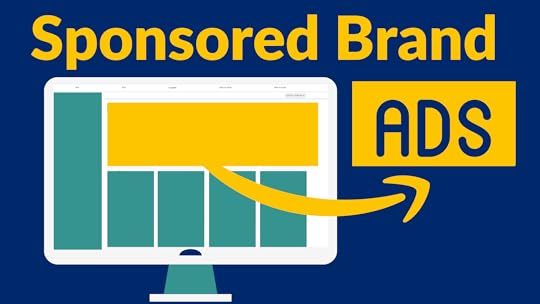
Similar to Sponsored Products Ads, these are PPC ads that use keywords and ASINs to target audiences. The main difference is that Sponsored Brands Ads feature your store and up to 3 products to highlight instead of a single product.
Strategically, this Amazon ad type can help achieve different objectives than Sponsored Products Ads, which are mostly meant to increase sales. For example, they can help meet KPIs if your main marketing goal is to increase brand awareness. Sponsored Brands Ads also have a larger variety of ad formats to accommodate the larger quantity of photos and creatives needed for them, such as the carousel format or Amazon Store Spotlight.
Sponsored Brands Ads also carry greater risk and reward. The best-performing Sponsored Brands Ads have higher click-through rates than the best-performing Sponsored Products Ads but have a lower click-through rate on average. In other words, the best Sponsored Brands Ads perform better, but this ad type is not as forgiving towards average-quality campaigns.
Where are Sponsored Brands ads placed?Sponsored Brands Ads also appear on search results pages and product details pages. The key difference in their placement compared to Sponsored Products ads is that they can appear within search results for mobile users. Their larger format makes them look remarkably different from Sponsored Products Ads from the perspective of the viewer, especially when at the top of the search results page.
How much do they cost?The minimum cost for Sponsored Brands Ads is also $1 per day (technically, as this is the minimum ad spend required). Just like with Sponsored Brands Ads, the ideal budget varies from seller to seller, so you should consider your bidding price, how long your ad will run, your advertising goals, etc.
When should you use Amazon Sponsored Brands Ads?If you’re a new Amazon seller. Sponsored Brands Ads are a great way to put your store in the spotlight to relevant customers without having to wait. This is especially true for brands that are not new themselves but are new to Amazon – the added conveniences for Amazon shoppers like prime delivery could be the final push for previously interested shoppers to make a purchase, so it’s important to make them aware of this new option.
If you have several new products or a family of products. For example, a skincare brand would benefit from using a Sponsored Brands Ad because shoppers tend to buy multiple products to cover their skincare routine.
If your main objective is to increase brand awareness. Sponsored Brands Ads will increase your sales, but they’re much more effective at increasing brand awareness compared to Sponsored Products Ads.
Sponsored Display Ads
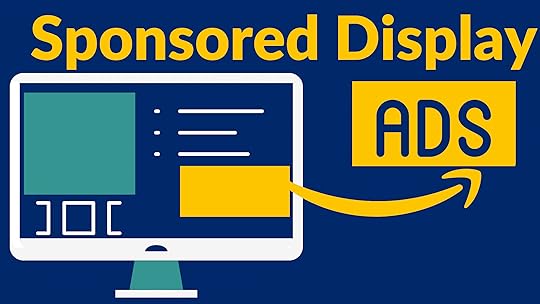
Previously known as Product Display Ads, Sponsored Display is a remarkably different type of Amazon ad compared to our previous two. Its appearance doesn’t look incredibly different, but its purpose and targeting method are completely different from Sponsored Products and Brands Ads.
Sponsored Display Ads are Amazon’s retargeting solution for sellers. They’re meant to be shown to people who’ve purchased similar products like yours, have shown interest in products similar to yours, and people who have purchased your products.
If you’re itching to make the most of Amazon’s incredible consumer data to boost your sales, this is the type of ad for you. Unlike Sponsored Brands or Sponsored Products Ads, Sponsored Display Ads use interest-based targeting and demographics data to find the right audiences for you. There are 3 options available:
Views Remarketing will target audiences who have viewed your products but did not make a purchase within the last 30 days, or who have viewed product pages that meet your criteria.
Search Remarketing is the only option that technically involves keywords because it targets audiences who searched for terms related to your products.
Purchase Remarketing allows you to target previous customers.
These 3 options provide many more strategy possibilities depending on what you advertise. For example, you could make a Sponsored Display Ad using purchase remarketing if your product is nondurable, like lotion or vitamins, or you could advertise a different product the buyer purchased using the same options.
Where are Amazon Sponsored Display Ads placed?Sponsored Display ads can show up on customer reviews pages, in the sidebar at the top of offer listings, on product details pages, and even on other sites. You read that correctly – if Amazon’s algorithms determine they’ve found your audience on one of Amazon’s affiliate platforms (Kindle, Twitch, etc.) your Sponsored Display Ad could appear, typically in a banner format.
How much do they cost?There is no minimum budget required for Sponsored Display Ads. They’re PPC ads like Sponsored Product and Sponsored Brands Ads, so you should budget your ads according to your bidding price, how long you want the campaign to run, your advertising budget, and so on. However, Sponsored Display Ads will give you an estimate of how many people your ad will reach as you’re setting up your campaign, which you can use to determine what your optimal budget should be.
When should you use Sponsored Display Ads?If your product is consumable. For products that require repurchasing, like body wash or candles.
If you want to target competitors. Sponsored Display Ads allow you to place your product right on the page of your direct competitors. This is especially useful if your product is a better deal.
If your goal is reach and exposure. By targeting based on user activity, Sponsored Display Ads are great for brand awareness and to boost new product listings. You can find new audiences you may have been missing via keyword targeting, or niche audiences that are interested in your product.



